Nina Munteanu's Blog, page 5
May 15, 2016
Nina Munteanu Interviewed by Joseph Planta of The Commentary
 I was recently interviewed by Joseph Planta of "The Commentary" in Vancouver about my new book
Water Is...
I was recently interviewed by Joseph Planta of "The Commentary" in Vancouver about my new book
Water Is...
Here's how he started the interview:
I am Planta: On the Line, in Vancouver, at TheCommentary.ca. We bathe in water, we drink it, we probably live around it or close to it, it flushes our toilets—we do so much with it, and it’s such an important aspect of our lives, but we waste it, we take it for granted, and we certainly don’t think about it as my next guest does. She has pondered water in an interesting, fascinating way. The title of the book is Water Is… and its author Nina Munteanu joins me now. She has spent a career as a limnologist and ecologist, and has conducted research, published papers and consulted in the environment, so she’s immersed well enough in water to tell us about how we should think about it. And the way she goes about it in this book is awfully good, in that she looks at water spiritually, artistically, and mythologically as well. Nina Munteanu is an award-winning novelist and short story writer as well, and currently teaches writing at the University of Toronto and George Brown College. The website for more is at www.themeaningofwater.com. The book is published by Pixl Press. Please welcome to the Planta: On the Line program, in Toronto today, Nina Munteanu; Ms. Munteanu, good morning...
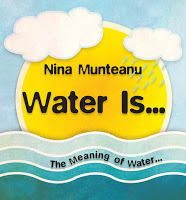 Our conversation flowed and surged like a living river, covering a range of topics--like the book itself--from ecology and quantum physics, to water's anomalous properties (like the Mpemba effect), water wars, spiritual connections and childhood memories. And what we as Canadians can and are doing.
Our conversation flowed and surged like a living river, covering a range of topics--like the book itself--from ecology and quantum physics, to water's anomalous properties (like the Mpemba effect), water wars, spiritual connections and childhood memories. And what we as Canadians can and are doing.Astute, intelligent and wonderfully inquisitive, Joseph helped create a memorable experience for me and, I'm sure, for listening audiences. I hope you enjoy it as much as I did.
Here's my Interview with Joseph .
 Joseph Planta
Joseph PlantaAuthor David Berner said it well: "Joseph Planta is quite simply one of the best interviewers working today, and he has been for quite a few years now. Far-ranging and ubiquitous in his tastes, he is always deeply researched and versed in the world of the person at the other end of the microphone."
I couldn't agree more.
Published on May 15, 2016 21:05
May 10, 2016
A Metaphysical Meander Down a Scientific Stream
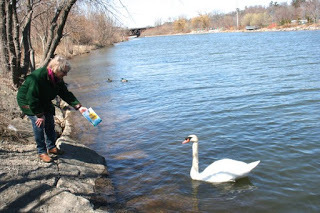 Nina and an interested "reader" of Water Is...That was the title John Stewart gave his interview article in the
MississaugaNews
last week on my book
Water Is…
In fact, as part of the interview, John and I did a meander over to the Credit River, featured in my recently released book about the myriad identities of water.
Nina and an interested "reader" of Water Is...That was the title John Stewart gave his interview article in the
MississaugaNews
last week on my book
Water Is…
In fact, as part of the interview, John and I did a meander over to the Credit River, featured in my recently released book about the myriad identities of water.We met at the Port Credit Second Cup on Lakeshore Avenue and talked for several hours over as many teas, then wandered across the bridge to the lower Credit, where I tried to interest several swans in my book. I almost succeeded, except the price—falling in the water—prevented me at the last moment. The sun was warm and the wind blustered as we watched the swans glide like luxury ships along the rocky shoreline. At this time of year the swans are nesting. In fact, Stewart later captured some beautiful shots of swans nesting at Lakefront Promenade Park in Mississauga (see shots I stole off Twitter: @JohnAtTheNews).
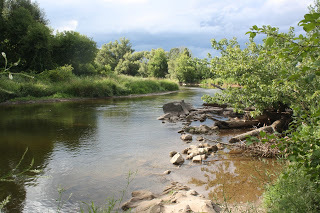 Credit River at Meadowvale
Credit River at Meadowvale“The book is a progressive journey, reflecting her career and life,” notes Stewart of Water Is… in his article. He and I talked a lot about the Credit River and why I’d chosen to feature it over the many other higher profile rivers I’d experienced—the Seine, Rhine, Fraser and Mississippi rivers for example. It was simple for me. Serendipity played a major role; The Credit River figured in my life journey at just the right time and it was accessible in a way that provided the kind of intimacy I needed as I wrote my book. I’d walked pretty much the whole length of it. Waded, I should say; because I was in the river, clamoring over the rocks in my Oakley flip-flops, most of the time.
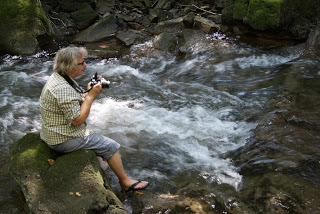 Nina photographing rapids of upper Credit River“The first chapters,” writes Stewart, “feature scientist and limnologist Nina, who spent a decade teaching at the University of Victoria and doing consulting science work and publishing papers. [Water Is…] gradually progresses, step by scientific step, to embrace things beyond science and into spirituality.” Einstein and many other scientists have made the same journey, I pointed out. “All great scientists at one point need to connect with God.”
Nina photographing rapids of upper Credit River“The first chapters,” writes Stewart, “feature scientist and limnologist Nina, who spent a decade teaching at the University of Victoria and doing consulting science work and publishing papers. [Water Is…] gradually progresses, step by scientific step, to embrace things beyond science and into spirituality.” Einstein and many other scientists have made the same journey, I pointed out. “All great scientists at one point need to connect with God.”“Most intriguing,” continues Stewart, “is the science that explains our emotional reactions to natural encounters. We feel better beside rushing water because negative ions, which have an extra electron, attach to positively charged ions from pollen, mould, bacteria, etc. and drag them to the ground. Thus the air is fresher.”
“[Water Is…] works on myriad levels,” says Stewart, “from top-notch trivia guide (the total amount of water in the atmosphere hasn’t changed since Earth’s formation) to science primer to cultural guide (Australian aboriginals douse for water through their feet, explaining that water in their bodies communicates with underground supplies.)”
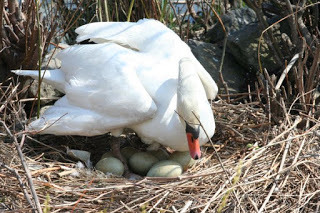 Photo by John Stewart
Photo by John Stewart“It’s part memoir and part philosophical exploration,” he says, “especially good when exploring the Da Vinci-esque bonds shared among science and art and design. It’s also a lay guide to the scientific and popular literature on the subject, chalk full of fascinating quotations…If you don’t want to read all those other books on water, just read this one.”
Water Is… “an exhilarating ride, even if you are not a science type. It’s filled with gentle eddies and contemplative pools on the connections between nature and man, inner and outer lives, and the struggle between your rational science side and your aspirational, artistic, spiritual side. You’ll find yourself revisiting a few vortexes and shifting undercurrents in your own life.”
Our conversation—like the meandering Credit River itself—flowed from ecology and water wars to quantum physics, entanglement and altruism. Stewart concluded his article with a note about new science regarding the emerging recognition of a cooperative universe. I’d mentioned that we are finding increasing evidence that all kinds of life demonstrate qualities of empathy and altruism. “We just need to look for it.”
“This book is a good place to start,” says Stewart.
See the original interview online here.
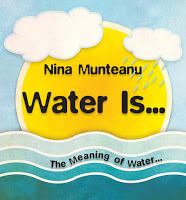 Water Is...
was released today worldwide and is featured as the #1 Hot New Release in Hydrology and is already an Amazon bestseller in several categories including Hydrology, Geology, Environmental Science and Natural Resources.
Water Is...
was released today worldwide and is featured as the #1 Hot New Release in Hydrology and is already an Amazon bestseller in several categories including Hydrology, Geology, Environmental Science and Natural Resources.
Published on May 10, 2016 19:33
May 8, 2016
Joyful Motherhood
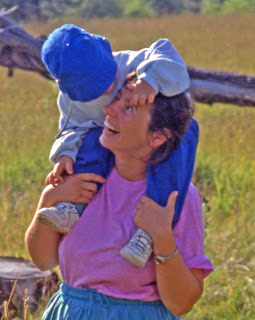 Kevin and Mom enjoy a hikeWhen I gave birth to my son, Kevin, I felt a miracle pass through me. I felt divinity touch me with a kind hand and whisper its joy. I was humbled, awestruck and so overjoyed. A little miracle had emerged out of me, completely formed and so beautiful!Kevin became my doorway to wonder. His curiosity was boundless and lured me into a special world of transformation.I took time off work to spend with Kevin when he was young. We went on great trips, from the local mall, where we had a hot chocolate and played with Lego, to the local beach on the Fraser River, where we explored the rocks. When he was no more than three, I took him on endless adventures in the city and its surroundings. We didn’t have to go far. The mud puddles of a new subdivision after a rain were sufficient to keep our attention for dozens of minutes. We became connoisseurs of mud. The best kind was “chocolate mud,” with a consistency and viscosity that created the best crater when a rock was thrown into it. Kevin and I often explored the little woodland a block from our house. We were hunters. Gatherers. Magicians. We made “magic potions” out of nightshade flowers, fir and pine needles, loam and moss; then we fuelled our concoctions with the elixir of water from a stagnant pool.
Kevin and Mom enjoy a hikeWhen I gave birth to my son, Kevin, I felt a miracle pass through me. I felt divinity touch me with a kind hand and whisper its joy. I was humbled, awestruck and so overjoyed. A little miracle had emerged out of me, completely formed and so beautiful!Kevin became my doorway to wonder. His curiosity was boundless and lured me into a special world of transformation.I took time off work to spend with Kevin when he was young. We went on great trips, from the local mall, where we had a hot chocolate and played with Lego, to the local beach on the Fraser River, where we explored the rocks. When he was no more than three, I took him on endless adventures in the city and its surroundings. We didn’t have to go far. The mud puddles of a new subdivision after a rain were sufficient to keep our attention for dozens of minutes. We became connoisseurs of mud. The best kind was “chocolate mud,” with a consistency and viscosity that created the best crater when a rock was thrown into it. Kevin and I often explored the little woodland a block from our house. We were hunters. Gatherers. Magicians. We made “magic potions” out of nightshade flowers, fir and pine needles, loam and moss; then we fuelled our concoctions with the elixir of water from a stagnant pool.
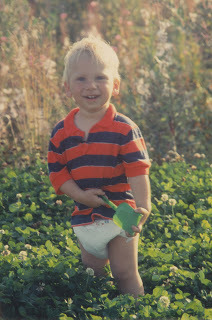 Kevin around 2 years oldBeing with my young son slowed my world and returned to me a great sense of wonder. A walk to the little store with young Kevin was an expedition. he’d amble, explore, poke, then suddenly squat and study something on the pavement that I’d missed.Kevin brought me back to the ground, to the extra-ordinary mundane—to the quiet details and the fragrant light. Acting like a macro lens, he pointed me to the little things, Nature’s nuanced designs that I’d forgotten in the larger paradigms of my hurried life.Kevin brought me back to the immediate, to Nature’s elegant silence and beauty. He showed me the fractal wonders of tree branches, exploding seeds, glorious reflections in puddles, strange mud waves and odd moss-covered rocks. We crouched in halted silence to watch a bee feast from a flower’s nectar then launch itself—a dirigible laden with pollen—into the sky.
Kevin around 2 years oldBeing with my young son slowed my world and returned to me a great sense of wonder. A walk to the little store with young Kevin was an expedition. he’d amble, explore, poke, then suddenly squat and study something on the pavement that I’d missed.Kevin brought me back to the ground, to the extra-ordinary mundane—to the quiet details and the fragrant light. Acting like a macro lens, he pointed me to the little things, Nature’s nuanced designs that I’d forgotten in the larger paradigms of my hurried life.Kevin brought me back to the immediate, to Nature’s elegant silence and beauty. He showed me the fractal wonders of tree branches, exploding seeds, glorious reflections in puddles, strange mud waves and odd moss-covered rocks. We crouched in halted silence to watch a bee feast from a flower’s nectar then launch itself—a dirigible laden with pollen—into the sky.
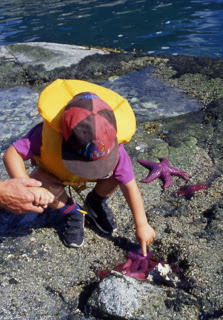 Kevin exploring the west coast We followed the brilliant Fibonacci spiral of a sunflower or the circular gossamer web of a spider, both mimicking the greater spiral of our own Milky Way Galaxy. We stuck our tongues out to taste the snow as it cascaded down in heaps or caught hexagonal snowflakes on our sleeves and sadly watched them melt. We stomped in road puddles or threw rocks and watched the circles of waves feed outward, changing the colour and texture of everything. We collected flotsam in nebulous forest pools and made magical potions. We wrote stories in the ocean sand, then leapt from dry rock to dry rock until the sea trapped us in its rushing embrace.Water’s beauty spans the subtle dewdrops on a suburban lawn to the extravagant and powerful surges of a tropical sea.
Kevin exploring the west coast We followed the brilliant Fibonacci spiral of a sunflower or the circular gossamer web of a spider, both mimicking the greater spiral of our own Milky Way Galaxy. We stuck our tongues out to taste the snow as it cascaded down in heaps or caught hexagonal snowflakes on our sleeves and sadly watched them melt. We stomped in road puddles or threw rocks and watched the circles of waves feed outward, changing the colour and texture of everything. We collected flotsam in nebulous forest pools and made magical potions. We wrote stories in the ocean sand, then leapt from dry rock to dry rock until the sea trapped us in its rushing embrace.Water’s beauty spans the subtle dewdrops on a suburban lawn to the extravagant and powerful surges of a tropical sea.
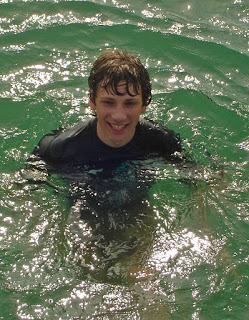 Kevin swimming in Georgia Strait“It’s hard to find anything more beautiful than dew on flower petals and leaves,” writes Masaru Emoto in The Secret Life of Water. “A single drop of dew falls off the tip of a sprouting leaf on a branch and makes its descent, through the forest canopy, and lands on the back of a frog ... Water spreads itself ... to shower love on the frog and the new sprout—and to be loved in return. Just as a mother instinctively loves her newborn, water in infancy is loved by all of nature.”In his book The Holy Order of Water: Healing the Earth’s Waters and Ourselves William E. Marks writes, “The mysteries flowing from water are with us in many ways—in the life surrounding us; in thoughts generated by our water-filled minds; the smells and rhythms of our oceans; the soothing sounds of gurgling streams and fountains; the beat of our hearts; the gift of sight from our watery eyes; the ever-changing clouds above; the misty fog that lightly kisses our faces; the sight of an awe-inspiring tornado; the vortex swirl of water disappearing down a drain.”
Kevin swimming in Georgia Strait“It’s hard to find anything more beautiful than dew on flower petals and leaves,” writes Masaru Emoto in The Secret Life of Water. “A single drop of dew falls off the tip of a sprouting leaf on a branch and makes its descent, through the forest canopy, and lands on the back of a frog ... Water spreads itself ... to shower love on the frog and the new sprout—and to be loved in return. Just as a mother instinctively loves her newborn, water in infancy is loved by all of nature.”In his book The Holy Order of Water: Healing the Earth’s Waters and Ourselves William E. Marks writes, “The mysteries flowing from water are with us in many ways—in the life surrounding us; in thoughts generated by our water-filled minds; the smells and rhythms of our oceans; the soothing sounds of gurgling streams and fountains; the beat of our hearts; the gift of sight from our watery eyes; the ever-changing clouds above; the misty fog that lightly kisses our faces; the sight of an awe-inspiring tornado; the vortex swirl of water disappearing down a drain.”
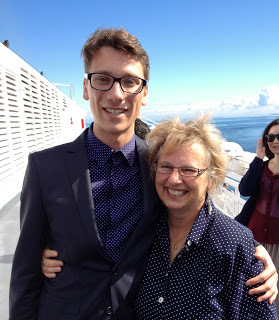 UVic grad Kevin and proud momWater is the bold light of change. Water is the deep purity of soul.
UVic grad Kevin and proud momWater is the bold light of change. Water is the deep purity of soul. Water is the abiding mother. And to be a mother is to be blessed.
This is an adapted excerpt from "Water Is..." (Pixl Press), currently available on Amazon.com and other great bookstores near you.
Published on May 08, 2016 14:31
April 4, 2016
When New Embraces Old: Part 1, the Journey
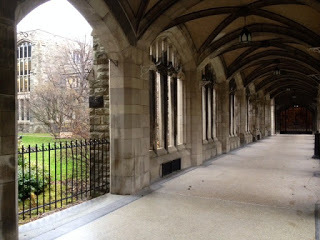 Breezeway of Knox CollegeWhen I first came to the University of Toronto to teach, I felt an abiding sense of “home” braced with the thrill of adventure. It was like “falling in love.” Really.
Breezeway of Knox CollegeWhen I first came to the University of Toronto to teach, I felt an abiding sense of “home” braced with the thrill of adventure. It was like “falling in love.” Really.To fall in love is like coming home, after all. And what is “home” but a tapestry of splendid memories whose textures weave us into who we presently are. It’s been three years since I came to UofT and I still feel that glowing thrill every time I walk through campus. Whether it’s past a century-old stone building, beneath a canopied archway of chestnuts, into a well-treed enclave, or through a high-ceilinged glass building; I am both home and on an adventure.
UofT is a place of learning—erudite, splendid, yet humble—beautifully epitomizing “new embracing old”. When new embraces old, we get magic. Wizard-magic. Harry Potter kind of magic. The kind of magic that only someone who is open, faithful, and confident can wield. This is ancient magic. The magic that lurks like Reznikoff’s ghost in the ancient halls of University College, or the magic currently wielded at 1 Spadina. A magic borne of wisdom, lore, and story.
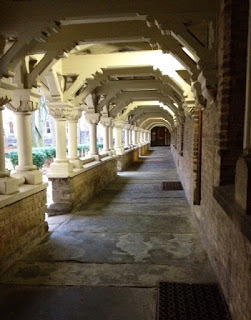 Courtyard behind University College
Courtyard behind University CollegeAll good stories understand and appreciate their origins. Good story builds on tradition toward something new and evolutionary. To journey forward, one must acknowledge the past. Ultimately, as Joseph Campbell said, that journey is a journey “home”.
UofT was founded 175 years ago as King’s College at the head of King’s circle. It was the first institution of higher learning in the colony of what was then Upper Canada. King’s College became the University of Toronto in 1849, and has steadily grown to include two more campuses (one in Scarborough and another in Mississauga), 9,000 faculty and staff and more than 60,000 graduate and undergraduate students. UofT has spawned major research achievements such as the discovery of insulin, the creation of the first electronic heart pacemaker, the single lung transplant and the discovery of the gene responsible for the most severe form of Alzheimer's disease. Recent advances include the discovery of the gene responsible for cystic fibrosis, cloning of the T-cell gene, and the world's first nerve transplant. During the research for my book Water Is… I continually ran across major achievements by UofT researchers in water and water-related science: from quantum entanglement in photosynthesis to billion-year water found in deep Canadian mine shafts. They are, of course, referred to in my book.
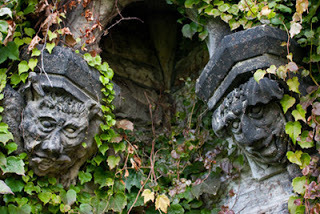 Diabolos and Reznikoff of University CollegeThe St. George campus of UofT lies embedded in the city of Toronto, steps away from the upscale shopping district of Yonge and Bloor and not much farther from the bustle of the financial district on King and Bay. It’s a bracing walk to Union Station, where every moving vehicle ends up at some time. UofT sprawls like an amoeba of neutrinos through the parliament buildings of University Avenue, making subtle changes here and there. Recreating the fabric of the cityscape in muonic subtleties.
Diabolos and Reznikoff of University CollegeThe St. George campus of UofT lies embedded in the city of Toronto, steps away from the upscale shopping district of Yonge and Bloor and not much farther from the bustle of the financial district on King and Bay. It’s a bracing walk to Union Station, where every moving vehicle ends up at some time. UofT sprawls like an amoeba of neutrinos through the parliament buildings of University Avenue, making subtle changes here and there. Recreating the fabric of the cityscape in muonic subtleties.This isn’t a typical century-old university campus, isolated from its city surroundings by an enclave of heritage buildings within an ornate campus of landscaped gardens and paths. UofT certainly has some of that. But the UofT downtown campus also sprawls dozens of blocks in all directions; embedding itself in the city with a blend of century-old buildings and avant-garde modern chic. It’s not so much re-inventing itself at every turn as morphing and co-evolving with the city. Old and new fold into one another, resembling symmetrical folds of metamorphic rock along a fault line. Like the entangled embrace of a Henry Moore sculpture.
I went on walkabout recently, after the last snows receded and gave way to the warm and restless winds of spring. The day blustered as I pulled up the collar of my spring coat and headed south from the St. George subway station. The sun beamed with the promise of hot summer days as the churlish wind stirred up leaves and debris into mini tornadoes. Winter’s detritus tracked a dizzy path, like whirling dervishes in tune with a seasonal dance.
I took my usual route south on St. George, toward Galbraith and Bahen buildings, where I teach, and soon found several examples of “new meets old”.
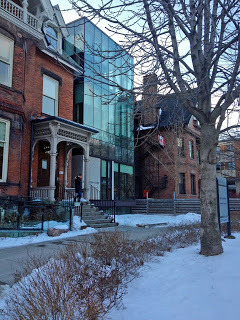 Max Gluskin HouseMax Gluskin House: UofT’s economics department recently expanded its home by connecting the department’s original Victorian and Georgian Revival buildings with a glass-enclosed hallway and a modern three-story addition called Max Gluskin House. The expansion unifies three heritage buildings with a contemporary glass building that creates an open connection. Its rust-coloured Corten steel harmonizes with the historic brick and, integrated with landscape features, provide an improved street presence.
Max Gluskin HouseMax Gluskin House: UofT’s economics department recently expanded its home by connecting the department’s original Victorian and Georgian Revival buildings with a glass-enclosed hallway and a modern three-story addition called Max Gluskin House. The expansion unifies three heritage buildings with a contemporary glass building that creates an open connection. Its rust-coloured Corten steel harmonizes with the historic brick and, integrated with landscape features, provide an improved street presence. Max Gluskin House includes a large undergraduate common room that faces into a courtyard, offices and research space for graduate students and faculty, rooms for TAs to meet with students, and expanded computer facilities. The project beautifully preserves and restores the beauty of the formal portions of the Victorian house, built in 1889 for William Crowther, and major portions of the Georgian building, completed in 1961. Ira Gluskin, who graduated from UofT’s commerce and finance program in 1964, provided the lead gift for the renovation. The facility is named in honour of his father, Max, who graduated from the same program in 1936.The renovation won second place in the commercial and institutional category of Toronto’s 2009 PUG Awards, the people’s choice awards in architecture.
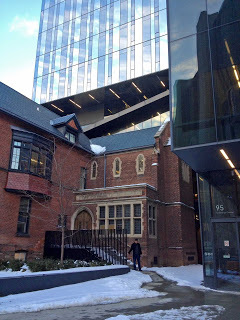 John Downey House embraced by RotmanRotman School of Management & John Downey House: When the Rotman School of Management needed to accommodate an ever-growing programming, student body, and faculty, it expanded 10-stories up right around John Downey House. Built in 1889, John Downey House typifies the Richardsonian Romanesque and Queen Anne Revival styles; called the Annex Style, it’s a blend of American and British architectural influences often associated with the wealthy.
John Downey House embraced by RotmanRotman School of Management & John Downey House: When the Rotman School of Management needed to accommodate an ever-growing programming, student body, and faculty, it expanded 10-stories up right around John Downey House. Built in 1889, John Downey House typifies the Richardsonian Romanesque and Queen Anne Revival styles; called the Annex Style, it’s a blend of American and British architectural influences often associated with the wealthy. The building emphasizes elaborate masonry and incorporates a prominent gable, woodwork and dormers. The Canadian School for Missions enlarged the building in 1929 with a two-storey addition in the Collegiate Gothic style. With the lofty backdrop of the Rotman Centre looming like a sentinel behind it, John Downey House sits like a russet island nested comfortably in a modern sea of cerulean glass. The centre itself, which I entered through an unassuming glass door, opens Tardis-like into an expansive open atrium with comfortable lounge and fireplace, study areas and stairways snaking up into ever higher levels
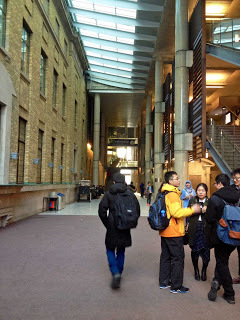 Atrium of Bahen with Koffler outer wallBahen & Koffler Buildings: The Bahen Centre for Information Technology was designed and built in 2002 to facilitate cross-disciplinary teaching and research for UofT’s Faculty of Arts and Science and the Faculty of Engineering. Named after John Bahen, president of the Peter Kiewit and Sons building company, it was based on the concept of a high-tech loft space, wrapping to the south and west around the 1909 Koffler Student Centre and to the north around 1878 Chadwick House.
Atrium of Bahen with Koffler outer wallBahen & Koffler Buildings: The Bahen Centre for Information Technology was designed and built in 2002 to facilitate cross-disciplinary teaching and research for UofT’s Faculty of Arts and Science and the Faculty of Engineering. Named after John Bahen, president of the Peter Kiewit and Sons building company, it was based on the concept of a high-tech loft space, wrapping to the south and west around the 1909 Koffler Student Centre and to the north around 1878 Chadwick House. The vaulting skylit arcade uses the Koffler Centre’s older outer wall as its south wall to provide pedestrian connections through the building; at its centre, a circular stair surrounds a glass tower of shared meeting rooms for eight levels.
Bahen’s north wing embraces Chadwick House, a
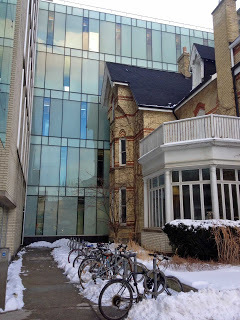 Chadwick House meets BahenVictorian house in a small courtyard opening off the street. The translucent glass of Bahen’s pavilion forms a contrasting backdrop to the connected Victorian building—with one of the best displays of dichromatic brickwork. The January 2003 issue of Canadian Architect magazine dubbed the Bahen Centre as "a complex interweaving of urbanity, public space and sustainability." It won the Ontario Association of Architects Award and City of Toronto Architecture and Urban Design Award, both in 2003. It also won a Bronze in the Environmental Category of the National Post Design Exchange Award.
Chadwick House meets BahenVictorian house in a small courtyard opening off the street. The translucent glass of Bahen’s pavilion forms a contrasting backdrop to the connected Victorian building—with one of the best displays of dichromatic brickwork. The January 2003 issue of Canadian Architect magazine dubbed the Bahen Centre as "a complex interweaving of urbanity, public space and sustainability." It won the Ontario Association of Architects Award and City of Toronto Architecture and Urban Design Award, both in 2003. It also won a Bronze in the Environmental Category of the National Post Design Exchange Award. Faculty Club loungeUofT Faculty Club: Every journey requires repast—a place to relax, eat and drink—and my feet naturally directed me to one of my new favourite haunts: the UofT Faculty Club. Located close to the hub of the campus, on Wilcox Street just east of Spadina, the club is open to members who include faculty, staff, graduate alumni and their guests. I entered the 1896 heritage building, built in a Georgian Revival-style, and passed the elegant first floor lounge to the pub below. The pub welcomed me with excellent food, drink and a relaxing ambience. Bathed in rich tones of wood and comfortable chairs and warmed by a cozy fireplace, it reminded me of a Dorset pub I’d visited years ago; full of colourful characters and a well-stocked bar. I felt both at home and like a traveler. Like I’d walked into history with modern comfort. I ordered the beet salad from my friendly waitress; it provided a refreshing and attractive light meal for a mid-day traveller.
Faculty Club loungeUofT Faculty Club: Every journey requires repast—a place to relax, eat and drink—and my feet naturally directed me to one of my new favourite haunts: the UofT Faculty Club. Located close to the hub of the campus, on Wilcox Street just east of Spadina, the club is open to members who include faculty, staff, graduate alumni and their guests. I entered the 1896 heritage building, built in a Georgian Revival-style, and passed the elegant first floor lounge to the pub below. The pub welcomed me with excellent food, drink and a relaxing ambience. Bathed in rich tones of wood and comfortable chairs and warmed by a cozy fireplace, it reminded me of a Dorset pub I’d visited years ago; full of colourful characters and a well-stocked bar. I felt both at home and like a traveler. Like I’d walked into history with modern comfort. I ordered the beet salad from my friendly waitress; it provided a refreshing and attractive light meal for a mid-day traveller. What better place to end my journey of “new embracing old” than in a place where “old embraces new.”
More in Part 2.
Published on April 04, 2016 20:55
March 10, 2016
Evolution, Digital Immortality and "Freenet"
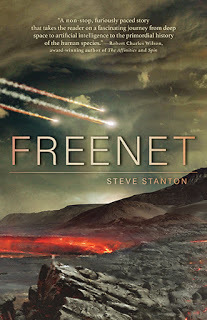 Steve Stanton’s fourth science fiction book Freenet explores humanity in the far future after we have created the “Macpherson Doorway” through folded space-time, and vaulted ourselves with the blink of an eye into a galaxy far far away and 12 million years into the future. No traffic back through the doorway is permitted since a quarantine was placed some dozen years ago to prevent any unwanted DNA from sneaking through from Earth to “New Jerusalem”.
Steve Stanton’s fourth science fiction book Freenet explores humanity in the far future after we have created the “Macpherson Doorway” through folded space-time, and vaulted ourselves with the blink of an eye into a galaxy far far away and 12 million years into the future. No traffic back through the doorway is permitted since a quarantine was placed some dozen years ago to prevent any unwanted DNA from sneaking through from Earth to “New Jerusalem”. As the back book jacket reveals, Freenet is a novel about the “power of [free] information…in a post-digital age.” The book explores what digital immortality means, when “consciousness has been digitized and cybersouls uploaded to a near-omniscient data-matrix.” This is a world where information “is currency and the truth belongs to whoever has the greatest bandwidth.”
Stanton shared with me that he was inspired to write the novel “from the simple observation of watching a woman lose her cellphone. Young people today are so tied to technology that they freak out when the strings are cut. In the future when life experience is delivered directly to the brain by wi-fi, the personal loss will be catastrophic.”
Told in three parts, the book begins with Simara Ying—a plugged-in V-net jockey and spacer—about to crash-land on the desert planet Bali. Her rescuer, a naïve—almost too nice to be true—native, Zen Valda, introduces her to his cave-dwelling culture with no social network support. The persistent electromagnetic storms of Bali interfere with digital communication and wipe all data. Like a baby removed from her comfortable womb, Simara survives panic attacks and heavy withdrawal chiefly because she is bombarded so heavily with Bali experiences that demand her attention. Lost without the support of her V-net—a comforting web of infinite communication and information—Simara struggles with Bali’s foreign ways. At every turn, she stumbles across some custom or taboo, forced to rely on her own wits; making the kind of mistakes she’s not used to making. More than a simple communication/information tool, the V-net embraces Simara with confidence. Without it, she fears she may go insane.
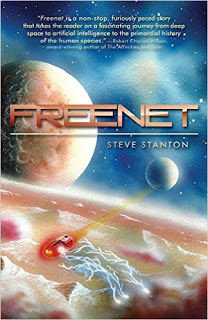 Canadian coverIntrigue arrives on Bali and chases Simara with a bounty on her head for murder. Zen demonstrates a simple faith in her innocence and helps her escape. Zen accepts a cochlear installation to connect him to the V-net, thinking it will help him better communicate with Simara, who—already somewhat distant—is even more so now that she has reunited with the V-net. The V-net instead overwhelms him with a surging sea of irrelevant chatter and information, which threatens to drive him insane. Struggling with chaotic information overload, he remains with Simara, even after she estranges herself from him and is captured for murder. They escape and survive an arranged “accident” by literally jumping into space from an abandoned troopship about to crash.
Canadian coverIntrigue arrives on Bali and chases Simara with a bounty on her head for murder. Zen demonstrates a simple faith in her innocence and helps her escape. Zen accepts a cochlear installation to connect him to the V-net, thinking it will help him better communicate with Simara, who—already somewhat distant—is even more so now that she has reunited with the V-net. The V-net instead overwhelms him with a surging sea of irrelevant chatter and information, which threatens to drive him insane. Struggling with chaotic information overload, he remains with Simara, even after she estranges herself from him and is captured for murder. They escape and survive an arranged “accident” by literally jumping into space from an abandoned troopship about to crash.The story deepens into nuanced commentary in the last third of the book when Roni Hendrik, an energetic V-net anchorman of the Daily Buzz, pokes into the intrigue surrounding Simara Ying. He discovers that she is biogenic, an omnidroid—bioengineered from human DNA—and likely smuggled from Earth.
Omnidroids share a major cerebral augmentation that includes unlimited access to the V-net, higher intelligence and an unknown possibility of enhancements, including pre-cognition and telepathy across vast distances. Created as effective firewalls and filters, omnidroids streamline all V-net data for users across the galaxy. “Omnidroids [are] born into zero-day digital space and live in a fantasyland far beyond the mortal sphere of intelligence,” Henrik reflects, sensing a deeper story than a simple murder conspiracy. “Physical experience and bodily sensation [are] only tiny fragments of their transcendent existence, mundane accessories to digital infinity. In time,” Henrik concludes, “life itself might become a vestigial appendage.”
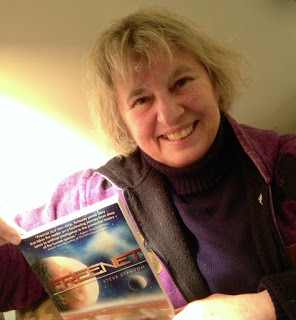 Nina holding a pre-release copy of FreenetHendrik, a humanist and closet idealist, pieces together connections with Neurozonics a New Jerusalem private corporation, responsible for the creation of biogenic humans. With holdings in a vast range of areas and an streaming amoeba of interests, Neurozonics is “a grinning spider on a translucent web of intrigue.” One discovery leads Henrik to more. He learns that the omnidroid community, to which Simara belongs, acts and communicates like a hive-mind, guided by a collective voice called “Mothership”. Other omnidroids have been targeted for elimination—and killed. Hell-bent on getting answers, Henrik confronts the owner of Neurozonics, Colin Macpherson—the same Macpherson who created the wormhole. Macpherson was uploaded earlier and runs his empire from digital space, part of the consortium of eternal intellect.
Nina holding a pre-release copy of FreenetHendrik, a humanist and closet idealist, pieces together connections with Neurozonics a New Jerusalem private corporation, responsible for the creation of biogenic humans. With holdings in a vast range of areas and an streaming amoeba of interests, Neurozonics is “a grinning spider on a translucent web of intrigue.” One discovery leads Henrik to more. He learns that the omnidroid community, to which Simara belongs, acts and communicates like a hive-mind, guided by a collective voice called “Mothership”. Other omnidroids have been targeted for elimination—and killed. Hell-bent on getting answers, Henrik confronts the owner of Neurozonics, Colin Macpherson—the same Macpherson who created the wormhole. Macpherson was uploaded earlier and runs his empire from digital space, part of the consortium of eternal intellect. Henrik’s meeting with Colin8 (the seventh clone of the original Colin Macpherson) runs like a “Neo-Architect” lecture in which the truth behind the omnidroids deaths is revealed. It’s not what you might think. Macpherson divulges his vision, which includes the reason for omnidroids’ communication abilities and the role of the Neurozonicbrain. The ultimate meaning and use of the omnidroid freenet ties to a greater destiny that redefines what it is to be human and subverts the history of our primordial origins.
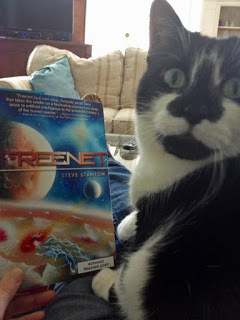 "Ma, can you read the part where the cat
"Ma, can you read the part where the cat omnidroid takes over the world?"The story flows seamlessly from one perspective to another with crisp page-turning narrative, action and intrigue. Stanton trades some richness of character for a page-turning plot and clever dialogue. If there is a weakness in the narrative for me, it lies with Simara, the arcane omnidroid, who remains mysterious—from her introduction aboard her ship about to crash land, to the limited revelations of her character during her interactions with Zen, both in her POV and in his. Considering her unique characteristics and experiences as an omnidroid, I would have enjoyed more insight to her unique outlook and perspective, especially when faced with no social network—perhaps the most frightening experience for an omnidroid: to be disconnected from the hive. On the other hand, Zen Valda as the simple Bali boy on an insane rollercoaster ride is painted with a sensitive and graceful hand. Stanton also skillfully portrays his news team, Roni and Gladyz, with finesse and subtly clever notes. The dialogue and overall interactions between them is some of the most enjoyable of the novel.
Ultimately, Stanton’s Freenetflows like a fresh turbulent river, scouring and building up sediment then meandering like an oxbow into areas that surprise. He lulls you into expectation, based on your own vision of the digital world, then—like a bubble bursting—releases a quantum paradox of wormhole possibility.
Freenet will be available in Canada on April 1 and in USA on April 12. Preorders are open on Amazon in both countries.
Published on March 10, 2016 09:55
January 1, 2016
2016—Year of the Cat?
“Do I contradict myself? Very well, I contradict myself. I am large, I contain multitudes.”—Walt Whitman
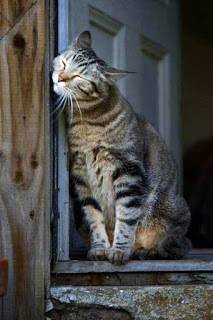 Leslie Wu of Forbes Magazine beat my tagline today in wishing you a Happy New Year: Says Wu: “Although we’ll be ringing in the year of the fire monkey for Chinese New Year in February, it could be said that 2016 will be the year of the cat…Cat cafes are springing up across Canada, where those lacking feline companionship can reserve time with these most reserved of creatures. From Vancouver to Montreal, the stressed, lonely or just plain cat deprived can cuddle their woes away with adoptable new friends (in partnership with the local SPCA or Humane Society). Although cat cafes have been popping up globally, Canada’s entry into the market has been relatively recent.”The domestic cat hasn’t always been in this position in society. In fact, the cat has had a complicated history with humanity since it first stepped into some Natufian’s rice granary and slammed its paw on a mouse. It hasn’t been easy for Felis silvestris sybica…
Leslie Wu of Forbes Magazine beat my tagline today in wishing you a Happy New Year: Says Wu: “Although we’ll be ringing in the year of the fire monkey for Chinese New Year in February, it could be said that 2016 will be the year of the cat…Cat cafes are springing up across Canada, where those lacking feline companionship can reserve time with these most reserved of creatures. From Vancouver to Montreal, the stressed, lonely or just plain cat deprived can cuddle their woes away with adoptable new friends (in partnership with the local SPCA or Humane Society). Although cat cafes have been popping up globally, Canada’s entry into the market has been relatively recent.”The domestic cat hasn’t always been in this position in society. In fact, the cat has had a complicated history with humanity since it first stepped into some Natufian’s rice granary and slammed its paw on a mouse. It hasn’t been easy for Felis silvestris sybica…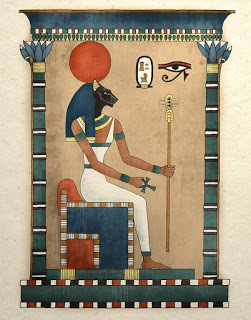 BastetFrom Bastet to a witch’s familiar… from the Chesire Cat to Schrödinger’s Cat … from Japan’s Beckoning Cat to Hello Kitty … from Aristophanes’ “the cat did it” to That Darn Cat’s wily DC … from Pokemon’s Meowth to A Cat in Paris … from Puss in Boots and Tom Kitten to Grumpy Cat … Humanity has deified, vilified, coddled and persecuted the domestic cat. Both icon and sacrifice, the domestic cat has lived in paradox alongside humanity for centuries. Perhaps because it is itself a paradox.When I observe my cat friend, furled out languidly, yet poised to leap, I recognize the unfettered wildcat deep in his soul. I recognize the anima mundi in his reflective eyes. The domestic cat embraces paradox: relaxed and alert; fierce and calm; tame and savage; mysterious and comforting. He embodies yin and yang.
BastetFrom Bastet to a witch’s familiar… from the Chesire Cat to Schrödinger’s Cat … from Japan’s Beckoning Cat to Hello Kitty … from Aristophanes’ “the cat did it” to That Darn Cat’s wily DC … from Pokemon’s Meowth to A Cat in Paris … from Puss in Boots and Tom Kitten to Grumpy Cat … Humanity has deified, vilified, coddled and persecuted the domestic cat. Both icon and sacrifice, the domestic cat has lived in paradox alongside humanity for centuries. Perhaps because it is itself a paradox.When I observe my cat friend, furled out languidly, yet poised to leap, I recognize the unfettered wildcat deep in his soul. I recognize the anima mundi in his reflective eyes. The domestic cat embraces paradox: relaxed and alert; fierce and calm; tame and savage; mysterious and comforting. He embodies yin and yang.
 The story of the domestic house cat’s evolving journey is subtle, complex and rife with contradiction. The domestic cat has evolved from wild hunter to opportunist predator and as partner alongside humanity as companion and symbol.It began about 11 million years ago when the Pseudaelurus, a medium-sized catlike animal, roamed the steppes of central Asia. Although it went extinct in Asia, receding sea levels permitted the Pseudaelurus to migrate across what is now the Red Sea into Africa, where it gave rise to the caracal and the serval. The Pseudaelurus also crossed the Bering land bridge into North America and gave rise to the lynx, bobcat and puma. Isolated migrants to South America created the ocelot and Geoffroy’s cat. The big cats—lions, tigers, jaquars and leopards—evolved in Asia then spread to other parts of the world.
The story of the domestic house cat’s evolving journey is subtle, complex and rife with contradiction. The domestic cat has evolved from wild hunter to opportunist predator and as partner alongside humanity as companion and symbol.It began about 11 million years ago when the Pseudaelurus, a medium-sized catlike animal, roamed the steppes of central Asia. Although it went extinct in Asia, receding sea levels permitted the Pseudaelurus to migrate across what is now the Red Sea into Africa, where it gave rise to the caracal and the serval. The Pseudaelurus also crossed the Bering land bridge into North America and gave rise to the lynx, bobcat and puma. Isolated migrants to South America created the ocelot and Geoffroy’s cat. The big cats—lions, tigers, jaquars and leopards—evolved in Asia then spread to other parts of the world.
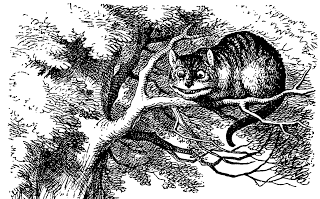
John Bradshaw, author of “Cat Sense”, writes that today’s domestic cat evolved some 8 million years ago in North America then migrated into Asia about 2 million years later. About 3 million years ago, they evolved into the species we know today, including the wildcat, the jungle cat and the sand cat—whose feet pads are covered in thick fur to protect them from the hot sand. The first signs of integration with human communities occurred some 10,000 BCE in Mesopotamia. Widely regarded as the inventors of agriculture, the Natufians of 11,000 to 8,000 BCE inhabited the once highly productive Fertile Crescent that encompassed what is now known as Israel-Palestine, Jordan, southwestern Syria and southern Lebanon. Initially hunter-gatherers, the Natufians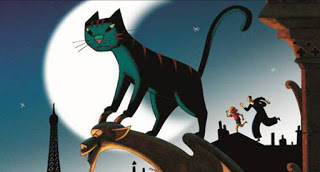 A Cat in Parisstarted growing crops such as wild cereals. When the climate changed perceptibly around 10,000 BCE, they adopted intensive farming practices that required extensive storage. Attracted to the bountiful harvested grain, the house mouse moved in. And right behind it came the small wildcat. As agriculture spread, so did the “domesticated” wildcat, exploiting a plentiful food source.Although several wildcats were associated with humanity, such as the fishing cat (Felis viverrina), the manul, and jaguarondi; the Arabian wildcat, Felis silvestris sybica, was identified through DNA testing as the “mother” cat of the domesticated cat we know today. Once so plentiful that it was considered a pest and hunted for food, this wildcat can still be found in remote areas of Europe, Africa, central and western Asia (where it may have first evolved). Felis silvestris comprises four subspecies: sylvestris (in Europe),lybica (Arabia), cafra (southern Africa), and ornata (Indian desert).
A Cat in Parisstarted growing crops such as wild cereals. When the climate changed perceptibly around 10,000 BCE, they adopted intensive farming practices that required extensive storage. Attracted to the bountiful harvested grain, the house mouse moved in. And right behind it came the small wildcat. As agriculture spread, so did the “domesticated” wildcat, exploiting a plentiful food source.Although several wildcats were associated with humanity, such as the fishing cat (Felis viverrina), the manul, and jaguarondi; the Arabian wildcat, Felis silvestris sybica, was identified through DNA testing as the “mother” cat of the domesticated cat we know today. Once so plentiful that it was considered a pest and hunted for food, this wildcat can still be found in remote areas of Europe, Africa, central and western Asia (where it may have first evolved). Felis silvestris comprises four subspecies: sylvestris (in Europe),lybica (Arabia), cafra (southern Africa), and ornata (Indian desert).
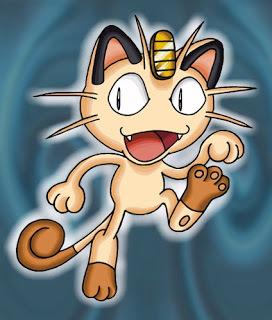 MeowthA cat was found buried alongside a human in a Neolithic grave in Cyprus from around 7,500 BCE. No burials of cats were recorded from the Middle East until thousands of years later. Was this an anomaly? Bradshaw thinks so: “a very special human and his prized tame wildcat.” In middle Egypt some 6,500 years ago a craftsman was buried with a gazelle (probably placed there for food in the afterlife) and a cat. Perhaps a pet? In Abydos, a tomb dating about 4,000 years ago, was uncovered that contained seventeen cat skeletons accompanied by seventeen pots—of milk? Egyptians began to paint and carve pet cats around then. A set of hieroglyphs—called “miw”—were created just for the domestic cat. Miw was adopted as a name for girls, suggesting how integrated the domestic cat had become in Egyptian society. Cats were depicted sitting in baskets or under a person’s chair (usually a female), and sometimes with a fish.
MeowthA cat was found buried alongside a human in a Neolithic grave in Cyprus from around 7,500 BCE. No burials of cats were recorded from the Middle East until thousands of years later. Was this an anomaly? Bradshaw thinks so: “a very special human and his prized tame wildcat.” In middle Egypt some 6,500 years ago a craftsman was buried with a gazelle (probably placed there for food in the afterlife) and a cat. Perhaps a pet? In Abydos, a tomb dating about 4,000 years ago, was uncovered that contained seventeen cat skeletons accompanied by seventeen pots—of milk? Egyptians began to paint and carve pet cats around then. A set of hieroglyphs—called “miw”—were created just for the domestic cat. Miw was adopted as a name for girls, suggesting how integrated the domestic cat had become in Egyptian society. Cats were depicted sitting in baskets or under a person’s chair (usually a female), and sometimes with a fish.
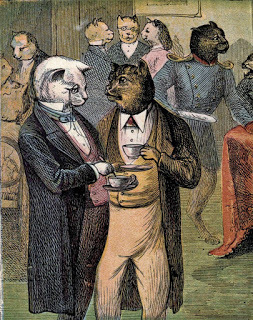 Miss Pussy Cat's Tea PartyEgypt doted on cats and worshipped them as god-animals. Bradshaw writes that the sun god, Ra, was occasionally depicted with the head of a cat and referred to as “Miuty.” Cat deities include: Pakhet, a lioness deity; and Sekhmet. Bastet was most associated with the domestic cat. She was the keeper of hearth and home, protector of women’s secrets, guardian against evil spirits and disease, and the goddess of cats. Bastet was commonly depicted as a woman with a lion’s head and carrying a serpent on her forehead. Later versions of Bastet more closely resembled a domestic cat as she became associated more with playfulness, fertility, motherhood, and female sexuality. Bastet or Bast was often associated with Isis (Ba-Ast translates to “soul of Isis”) and cats commonly found refuge in the temples of Isis. Fierceness and calm describes the goddess Isis as well as the cat. One theory of domestic cat distribution suggests that they followed the spread of temples of Isis. It was illegal to harm an Egyptian cat or to take it out of Egypt.
Miss Pussy Cat's Tea PartyEgypt doted on cats and worshipped them as god-animals. Bradshaw writes that the sun god, Ra, was occasionally depicted with the head of a cat and referred to as “Miuty.” Cat deities include: Pakhet, a lioness deity; and Sekhmet. Bastet was most associated with the domestic cat. She was the keeper of hearth and home, protector of women’s secrets, guardian against evil spirits and disease, and the goddess of cats. Bastet was commonly depicted as a woman with a lion’s head and carrying a serpent on her forehead. Later versions of Bastet more closely resembled a domestic cat as she became associated more with playfulness, fertility, motherhood, and female sexuality. Bastet or Bast was often associated with Isis (Ba-Ast translates to “soul of Isis”) and cats commonly found refuge in the temples of Isis. Fierceness and calm describes the goddess Isis as well as the cat. One theory of domestic cat distribution suggests that they followed the spread of temples of Isis. It was illegal to harm an Egyptian cat or to take it out of Egypt.
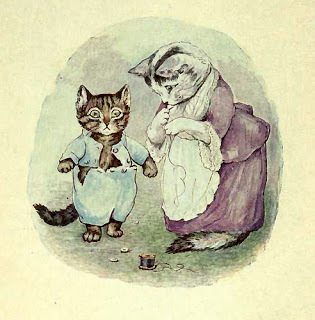 Tom KittenJoshua J. Mark, professor of philosophy at Marist College, New York, recounts how the Egyptian’s devotion to the cat was exploited by the Persians during the Battle of Pelusium (525 BCE) in which Cambyses II of Persia defeated the forces of the Egyptian Pharoah Psametik III to conquer Egypt. “Knowing of the Egyptian’s love for cats,” writes Mark, “Cambyses had his men round up various animals, cats chiefly among them, and drive the animals before the invading forces toward the fortified city of Pelusium on the Nile. The Persian soldiers painted images of cats on their shields, and may have held cats in their arms, as they marched behind the wall of animals. The Egyptians, reluctant to defend themselves for fear of harming the cats (and perhaps incurring the death penalty should they kill one), and demoralized at seeing the image of Bastet on the enemy’s shields, surrendered the city and let Egypt fall to the Persians.”
Tom KittenJoshua J. Mark, professor of philosophy at Marist College, New York, recounts how the Egyptian’s devotion to the cat was exploited by the Persians during the Battle of Pelusium (525 BCE) in which Cambyses II of Persia defeated the forces of the Egyptian Pharoah Psametik III to conquer Egypt. “Knowing of the Egyptian’s love for cats,” writes Mark, “Cambyses had his men round up various animals, cats chiefly among them, and drive the animals before the invading forces toward the fortified city of Pelusium on the Nile. The Persian soldiers painted images of cats on their shields, and may have held cats in their arms, as they marched behind the wall of animals. The Egyptians, reluctant to defend themselves for fear of harming the cats (and perhaps incurring the death penalty should they kill one), and demoralized at seeing the image of Bastet on the enemy’s shields, surrendered the city and let Egypt fall to the Persians.”
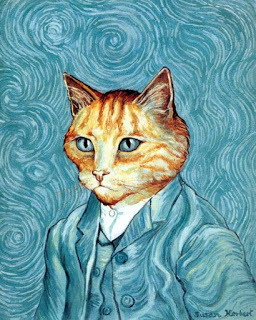 Van Gogh cat by Susan HerbertThe Egyptians are also responsible for the name “cat”, which comes from the North African word for the animal, quattah. Most Europeans use variations on this word: French, chat; Swedish, katt; German, katze; Italian, gatto; Spanish, gato. The colloquial word for a cat, “puss” or “pussy”, is also associated with Egypt in that it derives from the word Pasht, another name for Bastet.The Indian cat goddess, Sastht, was greatly revered much in the same way as Bastet. According to Mark, a Persian tale claims that the cat was created magically: “The great Persian hero Rustum, out on campaign, one night saved a magician from a band of thieves. Rustum offered the older man the hospitality of his tent and, as they sat outside under the stars, enjoying the warmth of a fire, the magician asked Rustum what he wished for as a gift in repayment for saving the man’s life. Rustum told him that there was nothing he desired since everything he could want, he already had before him in the warmth and comfort of the fire, the scent of the smoke and the beauty of
Van Gogh cat by Susan HerbertThe Egyptians are also responsible for the name “cat”, which comes from the North African word for the animal, quattah. Most Europeans use variations on this word: French, chat; Swedish, katt; German, katze; Italian, gatto; Spanish, gato. The colloquial word for a cat, “puss” or “pussy”, is also associated with Egypt in that it derives from the word Pasht, another name for Bastet.The Indian cat goddess, Sastht, was greatly revered much in the same way as Bastet. According to Mark, a Persian tale claims that the cat was created magically: “The great Persian hero Rustum, out on campaign, one night saved a magician from a band of thieves. Rustum offered the older man the hospitality of his tent and, as they sat outside under the stars, enjoying the warmth of a fire, the magician asked Rustum what he wished for as a gift in repayment for saving the man’s life. Rustum told him that there was nothing he desired since everything he could want, he already had before him in the warmth and comfort of the fire, the scent of the smoke and the beauty of
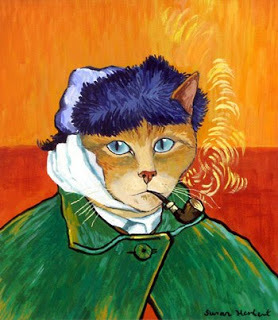 Van Gogh cat "after" by Susan Herbertthe stars overhead. The magician then took a handful of smoke, added flame, and brought down two of the brightest stars, kneading them together in his hands and blowing on them. When he opened his hands toward Rustum, the warrior saw a small, smoke-grey kitten with eyes bright as the stars and a tiny tongue, which darted like the tip of flame. In this way, the first Persian cat came to be created as a token of gratitude to Rustum. The prophet Muhammed was also very fond of cats. According to legend, the `M’ design on the forehead of the tabby cat was made when the prophet blessed his favourite cat by placing his hand on its head.”Cats are thought to have been brought to Europe by Phoenician traders who smuggled them out of Egypt. By about 2,400 years ago, domestic cats became popular in other parts of the world such as Greece and Italy. Paintings typically showed cats unleashed and relaxing in the presence of people. They also appeared on gravestones, obviously as the pets of the people buried there. Greeks called them aielouros or “waving tail.” The same occurred in Rome, where cats typically appeared with women (men more commonly appeared with a dog). Felicula (little kitten) became a common name for girls.As in Egypt, the domesticated cat became associated with goddesses in Greece and Italy, particularly Artemis or Diana. Ovid’s tale of mythical war between gods and giants, recounts how Diana escaped to Egypt and changed into a cat to escape capture. The cat was associated with Hecate, the goddess of death, darkness and witches. In the myth, Hera, enraged by the behaviour of a maidservant, transformed her into a cat and sent her to the underworld to serve Hecate.
Van Gogh cat "after" by Susan Herbertthe stars overhead. The magician then took a handful of smoke, added flame, and brought down two of the brightest stars, kneading them together in his hands and blowing on them. When he opened his hands toward Rustum, the warrior saw a small, smoke-grey kitten with eyes bright as the stars and a tiny tongue, which darted like the tip of flame. In this way, the first Persian cat came to be created as a token of gratitude to Rustum. The prophet Muhammed was also very fond of cats. According to legend, the `M’ design on the forehead of the tabby cat was made when the prophet blessed his favourite cat by placing his hand on its head.”Cats are thought to have been brought to Europe by Phoenician traders who smuggled them out of Egypt. By about 2,400 years ago, domestic cats became popular in other parts of the world such as Greece and Italy. Paintings typically showed cats unleashed and relaxing in the presence of people. They also appeared on gravestones, obviously as the pets of the people buried there. Greeks called them aielouros or “waving tail.” The same occurred in Rome, where cats typically appeared with women (men more commonly appeared with a dog). Felicula (little kitten) became a common name for girls.As in Egypt, the domesticated cat became associated with goddesses in Greece and Italy, particularly Artemis or Diana. Ovid’s tale of mythical war between gods and giants, recounts how Diana escaped to Egypt and changed into a cat to escape capture. The cat was associated with Hecate, the goddess of death, darkness and witches. In the myth, Hera, enraged by the behaviour of a maidservant, transformed her into a cat and sent her to the underworld to serve Hecate.
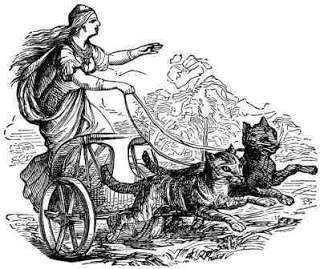 Freya and chariot catsIn early Europe cats were not yet persecuted. Norse mythology depicted feral cats pulling the chariot of Freya, the goddess of fertile life and Nature. In Ireland and Scotland cats were deemed magical—in a good way.The Pheonician traders may also have introduced to the rest of Europe the Greek association of the cat with Hecate. The association of cats with darkness, transformation, the underworld and witchcraft—and paganism in general—would lead to their persecution in Europe during the Middle Ages. Negative consequences of deification occurred both in Egypt and in Greece: in the form of cat sacrifice (and mummification). The ancient Celtic tradition of burying or killing cats to bring good luck also spread across Europe. European cities celebrated a Festival of Cats in which cats were thrown into a sac and suspended over a fire; their screams supposedly warded off evil spirits. In Ypres during Kattenstoet, cats were thrown from the top of a tower to save the town. The last time a live cat was thrown off the bell tower at Ypres, Belgium was as recent as 1817. The cat festival still occurs in Ypres using plush cats and a mock witch burning. As the Dark Ages gave way to the Middle Ages and Christianity established itself in Europe
Freya and chariot catsIn early Europe cats were not yet persecuted. Norse mythology depicted feral cats pulling the chariot of Freya, the goddess of fertile life and Nature. In Ireland and Scotland cats were deemed magical—in a good way.The Pheonician traders may also have introduced to the rest of Europe the Greek association of the cat with Hecate. The association of cats with darkness, transformation, the underworld and witchcraft—and paganism in general—would lead to their persecution in Europe during the Middle Ages. Negative consequences of deification occurred both in Egypt and in Greece: in the form of cat sacrifice (and mummification). The ancient Celtic tradition of burying or killing cats to bring good luck also spread across Europe. European cities celebrated a Festival of Cats in which cats were thrown into a sac and suspended over a fire; their screams supposedly warded off evil spirits. In Ypres during Kattenstoet, cats were thrown from the top of a tower to save the town. The last time a live cat was thrown off the bell tower at Ypres, Belgium was as recent as 1817. The cat festival still occurs in Ypres using plush cats and a mock witch burning. As the Dark Ages gave way to the Middle Ages and Christianity established itself in Europe
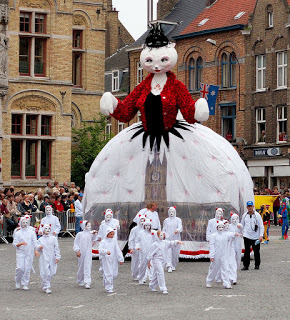 Katentoet 2015 in Ypres, Belgiumin the 12thand 13th centuries, cats suffered from their affiliation with pagan beliefs, which were considered cults and connected with Satan. The Catholic Church tried to extirpate domestic cats in continental Europe. On June 13th of 1233, Pope Gregory published his Vox in Ramawherein cats—particularly black cats—were demonized. Millions were tortured and killed, along with their female owners, who were considered witches. Some historians argue—though this has been disputed—that the aggressive killing of cats allowed the urban rodent and associated flea populations to thrive, which brought in the Bubonic Plague of the 1300s. Although also susceptible to the plague, enough cats must have survived both plague and human abuse to enjoy a better day.Elsewhere, the cats faired better. Bradshaw writes of the Sultan Baibars, ruler of Egypt and Syria, who founded the first sanctuary for homeless cats in Cairo in 1280.
Katentoet 2015 in Ypres, Belgiumin the 12thand 13th centuries, cats suffered from their affiliation with pagan beliefs, which were considered cults and connected with Satan. The Catholic Church tried to extirpate domestic cats in continental Europe. On June 13th of 1233, Pope Gregory published his Vox in Ramawherein cats—particularly black cats—were demonized. Millions were tortured and killed, along with their female owners, who were considered witches. Some historians argue—though this has been disputed—that the aggressive killing of cats allowed the urban rodent and associated flea populations to thrive, which brought in the Bubonic Plague of the 1300s. Although also susceptible to the plague, enough cats must have survived both plague and human abuse to enjoy a better day.Elsewhere, the cats faired better. Bradshaw writes of the Sultan Baibars, ruler of Egypt and Syria, who founded the first sanctuary for homeless cats in Cairo in 1280.
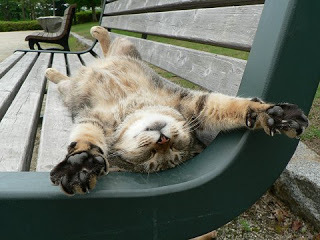 Cat lounging on a park benchToday, in North America and Europe and other parts of the world, the domestic and feral cat seem to enjoy a renaissance existence in which they are generally treated well or at least left alone.
Cat lounging on a park benchToday, in North America and Europe and other parts of the world, the domestic and feral cat seem to enjoy a renaissance existence in which they are generally treated well or at least left alone.
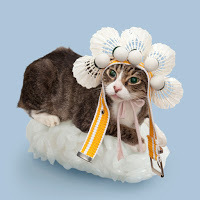 Sushi cat
Sushi cat
In Japan, a cat may find itself doted on to the point of “torture”. “Hello Kitty, arguably Japan’s most famous export, is only the tip of the iceberg,” wrote La Carmina in her blog post of 2013. “Take a walk around Tokyo, and you’ll see cat faces on every product imaginable...” from bowler hats with pointy ears, kitty petting zoos and Chesire cat pizza. Japanese folklore give cats a protective power that symbolize good fortune.
Marks writes about Japan’s “Beckoning Cat” (the maneki neko figure of the cat with one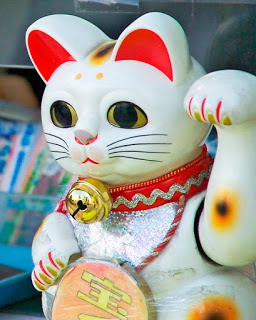 Maneki nekoraised paw), which represents the goddess of mercy. According to legend, a cat sitting outside of the temple of Gotoku-ji raised her paw to acknowledge the emperor who was passing by. Attracted by the cat’s gesture, the emperor entered the temple just as lightning struck the very spot where he had been standing; the cat had saved his life and was accorded great honours. The Beckoning Cat image is thought to bring good luck when given as a gift and remains a very popular present in Japan. Several islands off Japan have been called “Cat Island”. On Tashirojima Island in Ishinomaki City, cats come to welcome the boats at the port. Many wait patiently around the fishing port for fishermen to return. Neko-jinja located in the central area of the island enshrines a “cat god” in hope of a good catch and safety of the fishermen. Aoshima Island in the Shikoku area is also known as “Cat Island”. The catch-phrase of this island is “15 residents and 100 cats.”
Maneki nekoraised paw), which represents the goddess of mercy. According to legend, a cat sitting outside of the temple of Gotoku-ji raised her paw to acknowledge the emperor who was passing by. Attracted by the cat’s gesture, the emperor entered the temple just as lightning struck the very spot where he had been standing; the cat had saved his life and was accorded great honours. The Beckoning Cat image is thought to bring good luck when given as a gift and remains a very popular present in Japan. Several islands off Japan have been called “Cat Island”. On Tashirojima Island in Ishinomaki City, cats come to welcome the boats at the port. Many wait patiently around the fishing port for fishermen to return. Neko-jinja located in the central area of the island enshrines a “cat god” in hope of a good catch and safety of the fishermen. Aoshima Island in the Shikoku area is also known as “Cat Island”. The catch-phrase of this island is “15 residents and 100 cats.”
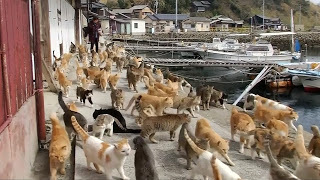 Cat Island, JapanIn Toronto, where I presently live, TOT the Cat Café, a coffee house, lounge and place to see and play with cats, has opened in November 2015 on College Street. The café has a lounge where patrons may interact with up to ten cats from the Toronto Humane Society (who are obviously up for adoption!). Friends and business partners, Kenneth Chai and Scott Tan are the cat fans behind the new café. The duo quit their jobs in Saskatoon and moved to Toronto, investing all their own money to realize their vision — a place that would offer both lattes and friendly felines. TOT is the first cat café in Toronto but not in Canada. There are several in Quebec, including Le Café Des Chats in Montreal (opened in 2014) and one in Chelsea, Quebec (Siberian Cat Café in late 2015) and Vancouver’s Catfé on West Pender, which opened in mid-December of 2015. Toronto’s Kitty Cat Café—self-professed “Purr Therapy and Coffee Lounge” in addition to pet adoption—will open soon.
Cat Island, JapanIn Toronto, where I presently live, TOT the Cat Café, a coffee house, lounge and place to see and play with cats, has opened in November 2015 on College Street. The café has a lounge where patrons may interact with up to ten cats from the Toronto Humane Society (who are obviously up for adoption!). Friends and business partners, Kenneth Chai and Scott Tan are the cat fans behind the new café. The duo quit their jobs in Saskatoon and moved to Toronto, investing all their own money to realize their vision — a place that would offer both lattes and friendly felines. TOT is the first cat café in Toronto but not in Canada. There are several in Quebec, including Le Café Des Chats in Montreal (opened in 2014) and one in Chelsea, Quebec (Siberian Cat Café in late 2015) and Vancouver’s Catfé on West Pender, which opened in mid-December of 2015. Toronto’s Kitty Cat Café—self-professed “Purr Therapy and Coffee Lounge” in addition to pet adoption—will open soon.
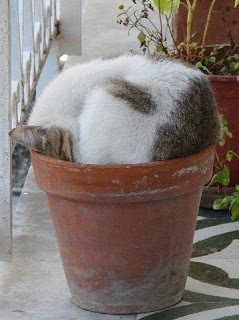 Cat sleeping in a pot
Cat sleeping in a pot
On the West Coast cat cafés exist in Portland, Oregon, San José, California, San Francisco and Los Angeles. The idea was born in Taiwan in 1998, and spread to Japan, where it's estimated there are now nearly 150 cat cafés, and Europe (e.g., Vienna).
References:
Bradshaw, John. 2013. “Cat Sense”. Basic Books, New York, NY. 307pp.Mark, Joshua J. 2012. “Cats in the Ancient World”. In: Ancient History Encyclopedia, 17 November, 2012. Online: http://www.ancient.eu/article/466/Wu, Leslie. 2016. "Cat Cafes Prowl Across Canada". Forbes Magazine. Online: http://www.forbes.com/sites/lesliewu/...
 Leslie Wu of Forbes Magazine beat my tagline today in wishing you a Happy New Year: Says Wu: “Although we’ll be ringing in the year of the fire monkey for Chinese New Year in February, it could be said that 2016 will be the year of the cat…Cat cafes are springing up across Canada, where those lacking feline companionship can reserve time with these most reserved of creatures. From Vancouver to Montreal, the stressed, lonely or just plain cat deprived can cuddle their woes away with adoptable new friends (in partnership with the local SPCA or Humane Society). Although cat cafes have been popping up globally, Canada’s entry into the market has been relatively recent.”The domestic cat hasn’t always been in this position in society. In fact, the cat has had a complicated history with humanity since it first stepped into some Natufian’s rice granary and slammed its paw on a mouse. It hasn’t been easy for Felis silvestris sybica…
Leslie Wu of Forbes Magazine beat my tagline today in wishing you a Happy New Year: Says Wu: “Although we’ll be ringing in the year of the fire monkey for Chinese New Year in February, it could be said that 2016 will be the year of the cat…Cat cafes are springing up across Canada, where those lacking feline companionship can reserve time with these most reserved of creatures. From Vancouver to Montreal, the stressed, lonely or just plain cat deprived can cuddle their woes away with adoptable new friends (in partnership with the local SPCA or Humane Society). Although cat cafes have been popping up globally, Canada’s entry into the market has been relatively recent.”The domestic cat hasn’t always been in this position in society. In fact, the cat has had a complicated history with humanity since it first stepped into some Natufian’s rice granary and slammed its paw on a mouse. It hasn’t been easy for Felis silvestris sybica… BastetFrom Bastet to a witch’s familiar… from the Chesire Cat to Schrödinger’s Cat … from Japan’s Beckoning Cat to Hello Kitty … from Aristophanes’ “the cat did it” to That Darn Cat’s wily DC … from Pokemon’s Meowth to A Cat in Paris … from Puss in Boots and Tom Kitten to Grumpy Cat … Humanity has deified, vilified, coddled and persecuted the domestic cat. Both icon and sacrifice, the domestic cat has lived in paradox alongside humanity for centuries. Perhaps because it is itself a paradox.When I observe my cat friend, furled out languidly, yet poised to leap, I recognize the unfettered wildcat deep in his soul. I recognize the anima mundi in his reflective eyes. The domestic cat embraces paradox: relaxed and alert; fierce and calm; tame and savage; mysterious and comforting. He embodies yin and yang.
BastetFrom Bastet to a witch’s familiar… from the Chesire Cat to Schrödinger’s Cat … from Japan’s Beckoning Cat to Hello Kitty … from Aristophanes’ “the cat did it” to That Darn Cat’s wily DC … from Pokemon’s Meowth to A Cat in Paris … from Puss in Boots and Tom Kitten to Grumpy Cat … Humanity has deified, vilified, coddled and persecuted the domestic cat. Both icon and sacrifice, the domestic cat has lived in paradox alongside humanity for centuries. Perhaps because it is itself a paradox.When I observe my cat friend, furled out languidly, yet poised to leap, I recognize the unfettered wildcat deep in his soul. I recognize the anima mundi in his reflective eyes. The domestic cat embraces paradox: relaxed and alert; fierce and calm; tame and savage; mysterious and comforting. He embodies yin and yang.
 The story of the domestic house cat’s evolving journey is subtle, complex and rife with contradiction. The domestic cat has evolved from wild hunter to opportunist predator and as partner alongside humanity as companion and symbol.It began about 11 million years ago when the Pseudaelurus, a medium-sized catlike animal, roamed the steppes of central Asia. Although it went extinct in Asia, receding sea levels permitted the Pseudaelurus to migrate across what is now the Red Sea into Africa, where it gave rise to the caracal and the serval. The Pseudaelurus also crossed the Bering land bridge into North America and gave rise to the lynx, bobcat and puma. Isolated migrants to South America created the ocelot and Geoffroy’s cat. The big cats—lions, tigers, jaquars and leopards—evolved in Asia then spread to other parts of the world.
The story of the domestic house cat’s evolving journey is subtle, complex and rife with contradiction. The domestic cat has evolved from wild hunter to opportunist predator and as partner alongside humanity as companion and symbol.It began about 11 million years ago when the Pseudaelurus, a medium-sized catlike animal, roamed the steppes of central Asia. Although it went extinct in Asia, receding sea levels permitted the Pseudaelurus to migrate across what is now the Red Sea into Africa, where it gave rise to the caracal and the serval. The Pseudaelurus also crossed the Bering land bridge into North America and gave rise to the lynx, bobcat and puma. Isolated migrants to South America created the ocelot and Geoffroy’s cat. The big cats—lions, tigers, jaquars and leopards—evolved in Asia then spread to other parts of the world.

John Bradshaw, author of “Cat Sense”, writes that today’s domestic cat evolved some 8 million years ago in North America then migrated into Asia about 2 million years later. About 3 million years ago, they evolved into the species we know today, including the wildcat, the jungle cat and the sand cat—whose feet pads are covered in thick fur to protect them from the hot sand. The first signs of integration with human communities occurred some 10,000 BCE in Mesopotamia. Widely regarded as the inventors of agriculture, the Natufians of 11,000 to 8,000 BCE inhabited the once highly productive Fertile Crescent that encompassed what is now known as Israel-Palestine, Jordan, southwestern Syria and southern Lebanon. Initially hunter-gatherers, the Natufians
 A Cat in Parisstarted growing crops such as wild cereals. When the climate changed perceptibly around 10,000 BCE, they adopted intensive farming practices that required extensive storage. Attracted to the bountiful harvested grain, the house mouse moved in. And right behind it came the small wildcat. As agriculture spread, so did the “domesticated” wildcat, exploiting a plentiful food source.Although several wildcats were associated with humanity, such as the fishing cat (Felis viverrina), the manul, and jaguarondi; the Arabian wildcat, Felis silvestris sybica, was identified through DNA testing as the “mother” cat of the domesticated cat we know today. Once so plentiful that it was considered a pest and hunted for food, this wildcat can still be found in remote areas of Europe, Africa, central and western Asia (where it may have first evolved). Felis silvestris comprises four subspecies: sylvestris (in Europe),lybica (Arabia), cafra (southern Africa), and ornata (Indian desert).
A Cat in Parisstarted growing crops such as wild cereals. When the climate changed perceptibly around 10,000 BCE, they adopted intensive farming practices that required extensive storage. Attracted to the bountiful harvested grain, the house mouse moved in. And right behind it came the small wildcat. As agriculture spread, so did the “domesticated” wildcat, exploiting a plentiful food source.Although several wildcats were associated with humanity, such as the fishing cat (Felis viverrina), the manul, and jaguarondi; the Arabian wildcat, Felis silvestris sybica, was identified through DNA testing as the “mother” cat of the domesticated cat we know today. Once so plentiful that it was considered a pest and hunted for food, this wildcat can still be found in remote areas of Europe, Africa, central and western Asia (where it may have first evolved). Felis silvestris comprises four subspecies: sylvestris (in Europe),lybica (Arabia), cafra (southern Africa), and ornata (Indian desert).
 MeowthA cat was found buried alongside a human in a Neolithic grave in Cyprus from around 7,500 BCE. No burials of cats were recorded from the Middle East until thousands of years later. Was this an anomaly? Bradshaw thinks so: “a very special human and his prized tame wildcat.” In middle Egypt some 6,500 years ago a craftsman was buried with a gazelle (probably placed there for food in the afterlife) and a cat. Perhaps a pet? In Abydos, a tomb dating about 4,000 years ago, was uncovered that contained seventeen cat skeletons accompanied by seventeen pots—of milk? Egyptians began to paint and carve pet cats around then. A set of hieroglyphs—called “miw”—were created just for the domestic cat. Miw was adopted as a name for girls, suggesting how integrated the domestic cat had become in Egyptian society. Cats were depicted sitting in baskets or under a person’s chair (usually a female), and sometimes with a fish.
MeowthA cat was found buried alongside a human in a Neolithic grave in Cyprus from around 7,500 BCE. No burials of cats were recorded from the Middle East until thousands of years later. Was this an anomaly? Bradshaw thinks so: “a very special human and his prized tame wildcat.” In middle Egypt some 6,500 years ago a craftsman was buried with a gazelle (probably placed there for food in the afterlife) and a cat. Perhaps a pet? In Abydos, a tomb dating about 4,000 years ago, was uncovered that contained seventeen cat skeletons accompanied by seventeen pots—of milk? Egyptians began to paint and carve pet cats around then. A set of hieroglyphs—called “miw”—were created just for the domestic cat. Miw was adopted as a name for girls, suggesting how integrated the domestic cat had become in Egyptian society. Cats were depicted sitting in baskets or under a person’s chair (usually a female), and sometimes with a fish.
 Miss Pussy Cat's Tea PartyEgypt doted on cats and worshipped them as god-animals. Bradshaw writes that the sun god, Ra, was occasionally depicted with the head of a cat and referred to as “Miuty.” Cat deities include: Pakhet, a lioness deity; and Sekhmet. Bastet was most associated with the domestic cat. She was the keeper of hearth and home, protector of women’s secrets, guardian against evil spirits and disease, and the goddess of cats. Bastet was commonly depicted as a woman with a lion’s head and carrying a serpent on her forehead. Later versions of Bastet more closely resembled a domestic cat as she became associated more with playfulness, fertility, motherhood, and female sexuality. Bastet or Bast was often associated with Isis (Ba-Ast translates to “soul of Isis”) and cats commonly found refuge in the temples of Isis. Fierceness and calm describes the goddess Isis as well as the cat. One theory of domestic cat distribution suggests that they followed the spread of temples of Isis. It was illegal to harm an Egyptian cat or to take it out of Egypt.
Miss Pussy Cat's Tea PartyEgypt doted on cats and worshipped them as god-animals. Bradshaw writes that the sun god, Ra, was occasionally depicted with the head of a cat and referred to as “Miuty.” Cat deities include: Pakhet, a lioness deity; and Sekhmet. Bastet was most associated with the domestic cat. She was the keeper of hearth and home, protector of women’s secrets, guardian against evil spirits and disease, and the goddess of cats. Bastet was commonly depicted as a woman with a lion’s head and carrying a serpent on her forehead. Later versions of Bastet more closely resembled a domestic cat as she became associated more with playfulness, fertility, motherhood, and female sexuality. Bastet or Bast was often associated with Isis (Ba-Ast translates to “soul of Isis”) and cats commonly found refuge in the temples of Isis. Fierceness and calm describes the goddess Isis as well as the cat. One theory of domestic cat distribution suggests that they followed the spread of temples of Isis. It was illegal to harm an Egyptian cat or to take it out of Egypt.
 Tom KittenJoshua J. Mark, professor of philosophy at Marist College, New York, recounts how the Egyptian’s devotion to the cat was exploited by the Persians during the Battle of Pelusium (525 BCE) in which Cambyses II of Persia defeated the forces of the Egyptian Pharoah Psametik III to conquer Egypt. “Knowing of the Egyptian’s love for cats,” writes Mark, “Cambyses had his men round up various animals, cats chiefly among them, and drive the animals before the invading forces toward the fortified city of Pelusium on the Nile. The Persian soldiers painted images of cats on their shields, and may have held cats in their arms, as they marched behind the wall of animals. The Egyptians, reluctant to defend themselves for fear of harming the cats (and perhaps incurring the death penalty should they kill one), and demoralized at seeing the image of Bastet on the enemy’s shields, surrendered the city and let Egypt fall to the Persians.”
Tom KittenJoshua J. Mark, professor of philosophy at Marist College, New York, recounts how the Egyptian’s devotion to the cat was exploited by the Persians during the Battle of Pelusium (525 BCE) in which Cambyses II of Persia defeated the forces of the Egyptian Pharoah Psametik III to conquer Egypt. “Knowing of the Egyptian’s love for cats,” writes Mark, “Cambyses had his men round up various animals, cats chiefly among them, and drive the animals before the invading forces toward the fortified city of Pelusium on the Nile. The Persian soldiers painted images of cats on their shields, and may have held cats in their arms, as they marched behind the wall of animals. The Egyptians, reluctant to defend themselves for fear of harming the cats (and perhaps incurring the death penalty should they kill one), and demoralized at seeing the image of Bastet on the enemy’s shields, surrendered the city and let Egypt fall to the Persians.”
 Van Gogh cat by Susan HerbertThe Egyptians are also responsible for the name “cat”, which comes from the North African word for the animal, quattah. Most Europeans use variations on this word: French, chat; Swedish, katt; German, katze; Italian, gatto; Spanish, gato. The colloquial word for a cat, “puss” or “pussy”, is also associated with Egypt in that it derives from the word Pasht, another name for Bastet.The Indian cat goddess, Sastht, was greatly revered much in the same way as Bastet. According to Mark, a Persian tale claims that the cat was created magically: “The great Persian hero Rustum, out on campaign, one night saved a magician from a band of thieves. Rustum offered the older man the hospitality of his tent and, as they sat outside under the stars, enjoying the warmth of a fire, the magician asked Rustum what he wished for as a gift in repayment for saving the man’s life. Rustum told him that there was nothing he desired since everything he could want, he already had before him in the warmth and comfort of the fire, the scent of the smoke and the beauty of
Van Gogh cat by Susan HerbertThe Egyptians are also responsible for the name “cat”, which comes from the North African word for the animal, quattah. Most Europeans use variations on this word: French, chat; Swedish, katt; German, katze; Italian, gatto; Spanish, gato. The colloquial word for a cat, “puss” or “pussy”, is also associated with Egypt in that it derives from the word Pasht, another name for Bastet.The Indian cat goddess, Sastht, was greatly revered much in the same way as Bastet. According to Mark, a Persian tale claims that the cat was created magically: “The great Persian hero Rustum, out on campaign, one night saved a magician from a band of thieves. Rustum offered the older man the hospitality of his tent and, as they sat outside under the stars, enjoying the warmth of a fire, the magician asked Rustum what he wished for as a gift in repayment for saving the man’s life. Rustum told him that there was nothing he desired since everything he could want, he already had before him in the warmth and comfort of the fire, the scent of the smoke and the beauty of
 Van Gogh cat "after" by Susan Herbertthe stars overhead. The magician then took a handful of smoke, added flame, and brought down two of the brightest stars, kneading them together in his hands and blowing on them. When he opened his hands toward Rustum, the warrior saw a small, smoke-grey kitten with eyes bright as the stars and a tiny tongue, which darted like the tip of flame. In this way, the first Persian cat came to be created as a token of gratitude to Rustum. The prophet Muhammed was also very fond of cats. According to legend, the `M’ design on the forehead of the tabby cat was made when the prophet blessed his favourite cat by placing his hand on its head.”Cats are thought to have been brought to Europe by Phoenician traders who smuggled them out of Egypt. By about 2,400 years ago, domestic cats became popular in other parts of the world such as Greece and Italy. Paintings typically showed cats unleashed and relaxing in the presence of people. They also appeared on gravestones, obviously as the pets of the people buried there. Greeks called them aielouros or “waving tail.” The same occurred in Rome, where cats typically appeared with women (men more commonly appeared with a dog). Felicula (little kitten) became a common name for girls.As in Egypt, the domesticated cat became associated with goddesses in Greece and Italy, particularly Artemis or Diana. Ovid’s tale of mythical war between gods and giants, recounts how Diana escaped to Egypt and changed into a cat to escape capture. The cat was associated with Hecate, the goddess of death, darkness and witches. In the myth, Hera, enraged by the behaviour of a maidservant, transformed her into a cat and sent her to the underworld to serve Hecate.
Van Gogh cat "after" by Susan Herbertthe stars overhead. The magician then took a handful of smoke, added flame, and brought down two of the brightest stars, kneading them together in his hands and blowing on them. When he opened his hands toward Rustum, the warrior saw a small, smoke-grey kitten with eyes bright as the stars and a tiny tongue, which darted like the tip of flame. In this way, the first Persian cat came to be created as a token of gratitude to Rustum. The prophet Muhammed was also very fond of cats. According to legend, the `M’ design on the forehead of the tabby cat was made when the prophet blessed his favourite cat by placing his hand on its head.”Cats are thought to have been brought to Europe by Phoenician traders who smuggled them out of Egypt. By about 2,400 years ago, domestic cats became popular in other parts of the world such as Greece and Italy. Paintings typically showed cats unleashed and relaxing in the presence of people. They also appeared on gravestones, obviously as the pets of the people buried there. Greeks called them aielouros or “waving tail.” The same occurred in Rome, where cats typically appeared with women (men more commonly appeared with a dog). Felicula (little kitten) became a common name for girls.As in Egypt, the domesticated cat became associated with goddesses in Greece and Italy, particularly Artemis or Diana. Ovid’s tale of mythical war between gods and giants, recounts how Diana escaped to Egypt and changed into a cat to escape capture. The cat was associated with Hecate, the goddess of death, darkness and witches. In the myth, Hera, enraged by the behaviour of a maidservant, transformed her into a cat and sent her to the underworld to serve Hecate.
 Freya and chariot catsIn early Europe cats were not yet persecuted. Norse mythology depicted feral cats pulling the chariot of Freya, the goddess of fertile life and Nature. In Ireland and Scotland cats were deemed magical—in a good way.The Pheonician traders may also have introduced to the rest of Europe the Greek association of the cat with Hecate. The association of cats with darkness, transformation, the underworld and witchcraft—and paganism in general—would lead to their persecution in Europe during the Middle Ages. Negative consequences of deification occurred both in Egypt and in Greece: in the form of cat sacrifice (and mummification). The ancient Celtic tradition of burying or killing cats to bring good luck also spread across Europe. European cities celebrated a Festival of Cats in which cats were thrown into a sac and suspended over a fire; their screams supposedly warded off evil spirits. In Ypres during Kattenstoet, cats were thrown from the top of a tower to save the town. The last time a live cat was thrown off the bell tower at Ypres, Belgium was as recent as 1817. The cat festival still occurs in Ypres using plush cats and a mock witch burning. As the Dark Ages gave way to the Middle Ages and Christianity established itself in Europe
Freya and chariot catsIn early Europe cats were not yet persecuted. Norse mythology depicted feral cats pulling the chariot of Freya, the goddess of fertile life and Nature. In Ireland and Scotland cats were deemed magical—in a good way.The Pheonician traders may also have introduced to the rest of Europe the Greek association of the cat with Hecate. The association of cats with darkness, transformation, the underworld and witchcraft—and paganism in general—would lead to their persecution in Europe during the Middle Ages. Negative consequences of deification occurred both in Egypt and in Greece: in the form of cat sacrifice (and mummification). The ancient Celtic tradition of burying or killing cats to bring good luck also spread across Europe. European cities celebrated a Festival of Cats in which cats were thrown into a sac and suspended over a fire; their screams supposedly warded off evil spirits. In Ypres during Kattenstoet, cats were thrown from the top of a tower to save the town. The last time a live cat was thrown off the bell tower at Ypres, Belgium was as recent as 1817. The cat festival still occurs in Ypres using plush cats and a mock witch burning. As the Dark Ages gave way to the Middle Ages and Christianity established itself in Europe
 Katentoet 2015 in Ypres, Belgiumin the 12thand 13th centuries, cats suffered from their affiliation with pagan beliefs, which were considered cults and connected with Satan. The Catholic Church tried to extirpate domestic cats in continental Europe. On June 13th of 1233, Pope Gregory published his Vox in Ramawherein cats—particularly black cats—were demonized. Millions were tortured and killed, along with their female owners, who were considered witches. Some historians argue—though this has been disputed—that the aggressive killing of cats allowed the urban rodent and associated flea populations to thrive, which brought in the Bubonic Plague of the 1300s. Although also susceptible to the plague, enough cats must have survived both plague and human abuse to enjoy a better day.Elsewhere, the cats faired better. Bradshaw writes of the Sultan Baibars, ruler of Egypt and Syria, who founded the first sanctuary for homeless cats in Cairo in 1280.
Katentoet 2015 in Ypres, Belgiumin the 12thand 13th centuries, cats suffered from their affiliation with pagan beliefs, which were considered cults and connected with Satan. The Catholic Church tried to extirpate domestic cats in continental Europe. On June 13th of 1233, Pope Gregory published his Vox in Ramawherein cats—particularly black cats—were demonized. Millions were tortured and killed, along with their female owners, who were considered witches. Some historians argue—though this has been disputed—that the aggressive killing of cats allowed the urban rodent and associated flea populations to thrive, which brought in the Bubonic Plague of the 1300s. Although also susceptible to the plague, enough cats must have survived both plague and human abuse to enjoy a better day.Elsewhere, the cats faired better. Bradshaw writes of the Sultan Baibars, ruler of Egypt and Syria, who founded the first sanctuary for homeless cats in Cairo in 1280.
 Cat lounging on a park benchToday, in North America and Europe and other parts of the world, the domestic and feral cat seem to enjoy a renaissance existence in which they are generally treated well or at least left alone.
Cat lounging on a park benchToday, in North America and Europe and other parts of the world, the domestic and feral cat seem to enjoy a renaissance existence in which they are generally treated well or at least left alone.
 Sushi cat
Sushi catIn Japan, a cat may find itself doted on to the point of “torture”. “Hello Kitty, arguably Japan’s most famous export, is only the tip of the iceberg,” wrote La Carmina in her blog post of 2013. “Take a walk around Tokyo, and you’ll see cat faces on every product imaginable...” from bowler hats with pointy ears, kitty petting zoos and Chesire cat pizza. Japanese folklore give cats a protective power that symbolize good fortune.
Marks writes about Japan’s “Beckoning Cat” (the maneki neko figure of the cat with one
 Maneki nekoraised paw), which represents the goddess of mercy. According to legend, a cat sitting outside of the temple of Gotoku-ji raised her paw to acknowledge the emperor who was passing by. Attracted by the cat’s gesture, the emperor entered the temple just as lightning struck the very spot where he had been standing; the cat had saved his life and was accorded great honours. The Beckoning Cat image is thought to bring good luck when given as a gift and remains a very popular present in Japan. Several islands off Japan have been called “Cat Island”. On Tashirojima Island in Ishinomaki City, cats come to welcome the boats at the port. Many wait patiently around the fishing port for fishermen to return. Neko-jinja located in the central area of the island enshrines a “cat god” in hope of a good catch and safety of the fishermen. Aoshima Island in the Shikoku area is also known as “Cat Island”. The catch-phrase of this island is “15 residents and 100 cats.”
Maneki nekoraised paw), which represents the goddess of mercy. According to legend, a cat sitting outside of the temple of Gotoku-ji raised her paw to acknowledge the emperor who was passing by. Attracted by the cat’s gesture, the emperor entered the temple just as lightning struck the very spot where he had been standing; the cat had saved his life and was accorded great honours. The Beckoning Cat image is thought to bring good luck when given as a gift and remains a very popular present in Japan. Several islands off Japan have been called “Cat Island”. On Tashirojima Island in Ishinomaki City, cats come to welcome the boats at the port. Many wait patiently around the fishing port for fishermen to return. Neko-jinja located in the central area of the island enshrines a “cat god” in hope of a good catch and safety of the fishermen. Aoshima Island in the Shikoku area is also known as “Cat Island”. The catch-phrase of this island is “15 residents and 100 cats.” Cat Island, JapanIn Toronto, where I presently live, TOT the Cat Café, a coffee house, lounge and place to see and play with cats, has opened in November 2015 on College Street. The café has a lounge where patrons may interact with up to ten cats from the Toronto Humane Society (who are obviously up for adoption!). Friends and business partners, Kenneth Chai and Scott Tan are the cat fans behind the new café. The duo quit their jobs in Saskatoon and moved to Toronto, investing all their own money to realize their vision — a place that would offer both lattes and friendly felines. TOT is the first cat café in Toronto but not in Canada. There are several in Quebec, including Le Café Des Chats in Montreal (opened in 2014) and one in Chelsea, Quebec (Siberian Cat Café in late 2015) and Vancouver’s Catfé on West Pender, which opened in mid-December of 2015. Toronto’s Kitty Cat Café—self-professed “Purr Therapy and Coffee Lounge” in addition to pet adoption—will open soon.
Cat Island, JapanIn Toronto, where I presently live, TOT the Cat Café, a coffee house, lounge and place to see and play with cats, has opened in November 2015 on College Street. The café has a lounge where patrons may interact with up to ten cats from the Toronto Humane Society (who are obviously up for adoption!). Friends and business partners, Kenneth Chai and Scott Tan are the cat fans behind the new café. The duo quit their jobs in Saskatoon and moved to Toronto, investing all their own money to realize their vision — a place that would offer both lattes and friendly felines. TOT is the first cat café in Toronto but not in Canada. There are several in Quebec, including Le Café Des Chats in Montreal (opened in 2014) and one in Chelsea, Quebec (Siberian Cat Café in late 2015) and Vancouver’s Catfé on West Pender, which opened in mid-December of 2015. Toronto’s Kitty Cat Café—self-professed “Purr Therapy and Coffee Lounge” in addition to pet adoption—will open soon.
 Cat sleeping in a pot
Cat sleeping in a potOn the West Coast cat cafés exist in Portland, Oregon, San José, California, San Francisco and Los Angeles. The idea was born in Taiwan in 1998, and spread to Japan, where it's estimated there are now nearly 150 cat cafés, and Europe (e.g., Vienna).
References:
Bradshaw, John. 2013. “Cat Sense”. Basic Books, New York, NY. 307pp.Mark, Joshua J. 2012. “Cats in the Ancient World”. In: Ancient History Encyclopedia, 17 November, 2012. Online: http://www.ancient.eu/article/466/Wu, Leslie. 2016. "Cat Cafes Prowl Across Canada". Forbes Magazine. Online: http://www.forbes.com/sites/lesliewu/...
Published on January 01, 2016 14:36
December 16, 2015
A Tardigrade Christmas (a different Christmas story...)
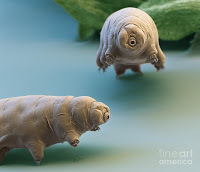
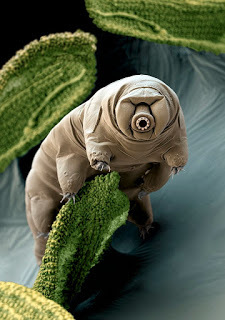 Blika lived in Mossland with her clone sestras, gathering and sucking the delicious juices of detritus and algae. Never looking up or in much of a hurry, she lumbered from frond to front on eight stubby legs in a gestalt of feasting and being.
Blika lived in Mossland with her clone sestras, gathering and sucking the delicious juices of detritus and algae. Never looking up or in much of a hurry, she lumbered from frond to front on eight stubby legs in a gestalt of feasting and being. Blika led a microscopic life of bloated bliss—unaware of forests, human beings, quantum physics or the coming singularity…A sudden fierce wind wicked her water away. In a burst of alien urgency, she wriggled madly for purchase on the frond as it shivered violently in the roaring wind. Blika lost hold and the wind swept her into a dark dryness. Her liquid life-force bleeding away from her, Blika crawled into herself. The moss piglet felt herself shrivel into oblivion.
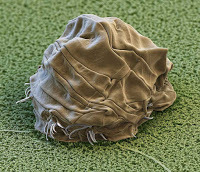 No, not oblivion… more like a vast expanse… She had entered a wonderland of twinkling lights in a vast fabric of dark matter. Where am I?It occurred to her that she had never thought such a thing before. Am I dead? She’d never thought about existence before either. What has happened to me? And where are my sestras? She felt an overwhelming sadness. Something else she’d never felt before and wondered why she hadn’t. Did it have to do with that liquid that had always embraced her with its life-force?
No, not oblivion… more like a vast expanse… She had entered a wonderland of twinkling lights in a vast fabric of dark matter. Where am I?It occurred to her that she had never thought such a thing before. Am I dead? She’d never thought about existence before either. What has happened to me? And where are my sestras? She felt an overwhelming sadness. Something else she’d never felt before and wondered why she hadn’t. Did it have to do with that liquid that had always embraced her with its life-force?
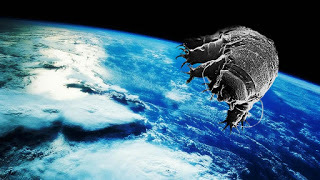 Here, in the darkness of space, she felt alone for the first time, separated from the plenum. “Welcome, sestra!” boomed a large voice. Blika beheld a being like her with eight arms and hands, seated on a throne and wearing a jeweled crown. “Why do you call me sestra?” Blika asked.“Because we are ALL sestras! You are a Tardigrade, aren’t you?” She waved all eight arms at Blika. “Well, I am your queen!” She looked self-pleased. “You are in Tunland now! The land of awareness. And now that you are self-aware, you can do anything! We’re special,” the queen ended in smug delight. The folds of her body jiggled and shimmered.
Here, in the darkness of space, she felt alone for the first time, separated from the plenum. “Welcome, sestra!” boomed a large voice. Blika beheld a being like her with eight arms and hands, seated on a throne and wearing a jeweled crown. “Why do you call me sestra?” Blika asked.“Because we are ALL sestras! You are a Tardigrade, aren’t you?” She waved all eight arms at Blika. “Well, I am your queen!” She looked self-pleased. “You are in Tunland now! The land of awareness. And now that you are self-aware, you can do anything! We’re special,” the queen ended in smug delight. The folds of her body jiggled and shimmered.
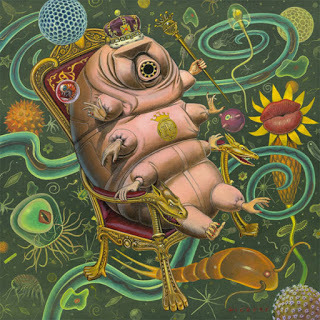 “Why are we special?” Blika asked.“Because we are!” the queen said sharply, already losing patience with her new subject. “Don’t you know that you can survive anything? Ionizing radiation. Huge pressure. Boiling heat. Freezing cold. Absolutely no air. And no water…” Blika gasped. Water was the elixor that connected her to her sestras and her world… her…home…“How do you think you got here, eh?” the queen mocked her with a sinister laugh. Blika cringed. The queen went on blithely, “So, where do you come from, piglet?”“I’m trying to find my way home…”“Your way? All ways here are my ways!”“But I was just thinking—”“I warn you, child…” The queen glowered at her. “If I lose my temper, you lose your head. Understand?”
“Why are we special?” Blika asked.“Because we are!” the queen said sharply, already losing patience with her new subject. “Don’t you know that you can survive anything? Ionizing radiation. Huge pressure. Boiling heat. Freezing cold. Absolutely no air. And no water…” Blika gasped. Water was the elixor that connected her to her sestras and her world… her…home…“How do you think you got here, eh?” the queen mocked her with a sinister laugh. Blika cringed. The queen went on blithely, “So, where do you come from, piglet?”“I’m trying to find my way home…”“Your way? All ways here are my ways!”“But I was just thinking—”“I warn you, child…” The queen glowered at her. “If I lose my temper, you lose your head. Understand?”
 Blika nodded, now missing her home even more. “Why thinkwhen you can do!” the queen added, suddenly cheerful again. “First there is BE, then THINK, then DO. Why not skip the think part and go straight to the do part? In Tunland we do that all the time,” she went on blithely. “And, as I was saying, here we can do anything!”The queen grabbed Blika by an arm and steered them through the swirling darkness of space toward a box-like floating object. “This is my doctor’s Tardis…”“Doctor who?” Blika naively asked.The queen shivered off her annoyance and led them eagerly through the door and into her kingdom. They entered a strange place of giant blocks and whining sounds beneath a dark swirling sky. The first thing Blika noticed was the huge tardigrades floating above them like dirigibles! Others were dressed in suits holding little suitcases and walking into and out of the huge blocks through doorways.
Blika nodded, now missing her home even more. “Why thinkwhen you can do!” the queen added, suddenly cheerful again. “First there is BE, then THINK, then DO. Why not skip the think part and go straight to the do part? In Tunland we do that all the time,” she went on blithely. “And, as I was saying, here we can do anything!”The queen grabbed Blika by an arm and steered them through the swirling darkness of space toward a box-like floating object. “This is my doctor’s Tardis…”“Doctor who?” Blika naively asked.The queen shivered off her annoyance and led them eagerly through the door and into her kingdom. They entered a strange place of giant blocks and whining sounds beneath a dark swirling sky. The first thing Blika noticed was the huge tardigrades floating above them like dirigibles! Others were dressed in suits holding little suitcases and walking into and out of the huge blocks through doorways.
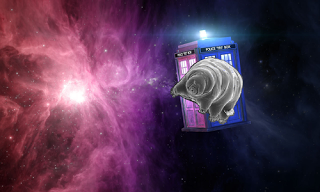 “We’ve crossed into another dimension—my universe,” the queen announced cheerfully. “Here you can do anything you want. So, why be tiny and feckless when you can be huge and powerful!” She studied Blika. “This is your moment to do what you could never do before. Think of the possibilities! You too could be huge!”Blika stared at the strange world of smoke and metal and yearned for her simple mossy home. As if she knew what Blika wanted, the queen quickly added, “But you can never go back home!”“Why not?” Blika asked, disappointed.
“We’ve crossed into another dimension—my universe,” the queen announced cheerfully. “Here you can do anything you want. So, why be tiny and feckless when you can be huge and powerful!” She studied Blika. “This is your moment to do what you could never do before. Think of the possibilities! You too could be huge!”Blika stared at the strange world of smoke and metal and yearned for her simple mossy home. As if she knew what Blika wanted, the queen quickly added, “But you can never go back home!”“Why not?” Blika asked, disappointed.
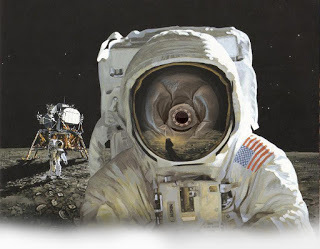 “Because, that’s why!” the queen shouted. Squinting, she added, “It’s too late. It’s just not done! Once you’ve learned what the colour green means you can’t erase its significance!”“But I stilldon’t know what the colour green means,” Blika complained. “And, besides, I think you’re wrong. Becoming self-aware doesn’t stop you from going home. It just changes its meaning. And if I can really do what I want, then you can’t stop me. I’m going home to my family.” The little hairs on the queen bristled. Then she grew terribly calm. “I won’t stop you, but…” The queen pointed to the floating tardigrades above them. “My water bear army will. I sentence you to remain in Tunland forever for your crime!” “I haven’t done anything…yet.”“You’ve broken the law of thinking before doing. In Tunland you have to skip that part—”“You just made that up—”
“Because, that’s why!” the queen shouted. Squinting, she added, “It’s too late. It’s just not done! Once you’ve learned what the colour green means you can’t erase its significance!”“But I stilldon’t know what the colour green means,” Blika complained. “And, besides, I think you’re wrong. Becoming self-aware doesn’t stop you from going home. It just changes its meaning. And if I can really do what I want, then you can’t stop me. I’m going home to my family.” The little hairs on the queen bristled. Then she grew terribly calm. “I won’t stop you, but…” The queen pointed to the floating tardigrades above them. “My water bear army will. I sentence you to remain in Tunland forever for your crime!” “I haven’t done anything…yet.”“You’ve broken the law of thinking before doing. In Tunland you have to skip that part—”“You just made that up—”
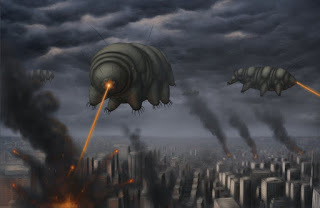 “Doesn’t matter!” shouted the queen. “Sentence first, verdict afterwards!” “That’s nonsense,” said Blika loudly. “The idea of having the sentence first.”“Hold your tongue!” said the queen, turning a shade of chartreuse.“I won’t,” said Blika.“Off with your head!” the queen shouted at the top of her voice, pointing to Blika with all eight of her appendages. The water bear army hovered over Blika, taking aim. They were going to get more than her head with those lasers, Blika thought, and scurried for cover faster than her stubby eight legs had ever moved before. She was doomed— Then, just beyond her sight, she saw—no felt—something far more significant than the colour green…or a huge bloated water bear army about to shoot her…
“Doesn’t matter!” shouted the queen. “Sentence first, verdict afterwards!” “That’s nonsense,” said Blika loudly. “The idea of having the sentence first.”“Hold your tongue!” said the queen, turning a shade of chartreuse.“I won’t,” said Blika.“Off with your head!” the queen shouted at the top of her voice, pointing to Blika with all eight of her appendages. The water bear army hovered over Blika, taking aim. They were going to get more than her head with those lasers, Blika thought, and scurried for cover faster than her stubby eight legs had ever moved before. She was doomed— Then, just beyond her sight, she saw—no felt—something far more significant than the colour green…or a huge bloated water bear army about to shoot her…
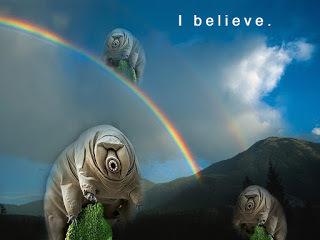 Water! She could taste it, smell it, hear it. Blika rejoiced with thoughts of her green home.The water came in a giant wet wave of blue and silver and frothy green. Tunland sloshed then totally dissolved. Blika surfed the churning water. That green! She knew what it was! Blika reached out with her deft claws and snagged a tumbling moss frond. It finally settled and there were her sestras! So many of them clinging to the same green moss! She’d found her family! She was home! Yes, it was a different home and different sestras, but it was also the same. Love made it so…For the first time, Blika looked up … and saw a bright star…
Water! She could taste it, smell it, hear it. Blika rejoiced with thoughts of her green home.The water came in a giant wet wave of blue and silver and frothy green. Tunland sloshed then totally dissolved. Blika surfed the churning water. That green! She knew what it was! Blika reached out with her deft claws and snagged a tumbling moss frond. It finally settled and there were her sestras! So many of them clinging to the same green moss! She’d found her family! She was home! Yes, it was a different home and different sestras, but it was also the same. Love made it so…For the first time, Blika looked up … and saw a bright star… ~~~
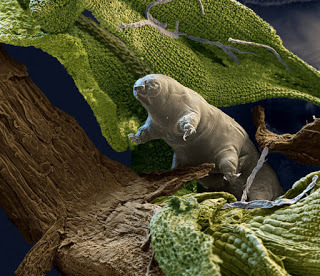 Tardigrades, also known as water bears or moss piglets, are plump, microscopic organisms with eight clawed legs. Fossils of tardigrades date to the Cambrian period over 500 million years ago. Over 900 species are known. Tardigrades were first described by the German pastor Johann August Ephraim Goeze in 1773 and given the name Tardigrada, meaning “slow stepper,” by the Italian biologist Lazzaro Spallanzani. Tardigrades reproduce asexually (parthenogenesis) or sexually. They mostly suck on the fluids of plant cells, animal cells, and bacteria. Tardigrades survive adverse environmental stresses including:• High and low temperatures (e.g., -273°C to +151°C)• freezing and thawing• changes in salinity• lack of oxygen• lack of water• levels of X-ray radiation 1000x the lethal human dose• some toxic chemicals• boiling alcohol• low pressure of a vacuum• high pressure (up to 6x the pressure of the deepest ocean).
Tardigrades, also known as water bears or moss piglets, are plump, microscopic organisms with eight clawed legs. Fossils of tardigrades date to the Cambrian period over 500 million years ago. Over 900 species are known. Tardigrades were first described by the German pastor Johann August Ephraim Goeze in 1773 and given the name Tardigrada, meaning “slow stepper,” by the Italian biologist Lazzaro Spallanzani. Tardigrades reproduce asexually (parthenogenesis) or sexually. They mostly suck on the fluids of plant cells, animal cells, and bacteria. Tardigrades survive adverse environmental stresses including:• High and low temperatures (e.g., -273°C to +151°C)• freezing and thawing• changes in salinity• lack of oxygen• lack of water• levels of X-ray radiation 1000x the lethal human dose• some toxic chemicals• boiling alcohol• low pressure of a vacuum• high pressure (up to 6x the pressure of the deepest ocean).
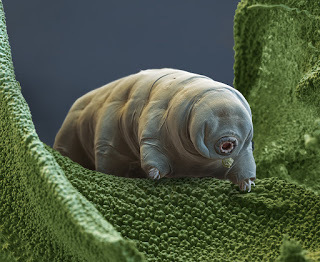 Tardigrades respond to adverse environmental stresses through “cryptobiosis”, a process that greatly slows their metabolism. Tardigrades survive dry periods by shriveling up into a little ball or tun and waiting it out. They make a protective sugar called trehalose, which moves into the cells to replace the lost water. You could say that the water bear turns into a gummy bear.
Tardigrades respond to adverse environmental stresses through “cryptobiosis”, a process that greatly slows their metabolism. Tardigrades survive dry periods by shriveling up into a little ball or tun and waiting it out. They make a protective sugar called trehalose, which moves into the cells to replace the lost water. You could say that the water bear turns into a gummy bear.
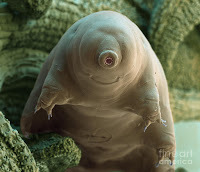 Tardigrades have revived after a 100 years of desiccation. The antioxidants they make soak up dangerous chemicals and tardigrades can also repair damaged DNA from long term dry-out. In low oxygen, the tardigrade stretches out, relaxed muscles letting more water and oxygen enter its cells. The tardigrade’s cold-resistant tun also prevent the formation of ice crystals that could damage cell membranes. Tardigrades survive temperatures, pressures and ionizing radiation not normally found on Earth. All this raises questions of origin and evolutionary adaptation. How—and why—have tardigrades developed the ability to survive the vacuum and ionizing radiation of space? Some suggest that it’s because they originated there. Scientists argue that they developed extreme tolerances from Earth’s volatile environments (e.g., water bodies that freeze or dry up, and undergo anoxia). But, if they can make it there, they can make it anywhere. So, where is “home” really?…
Tardigrades have revived after a 100 years of desiccation. The antioxidants they make soak up dangerous chemicals and tardigrades can also repair damaged DNA from long term dry-out. In low oxygen, the tardigrade stretches out, relaxed muscles letting more water and oxygen enter its cells. The tardigrade’s cold-resistant tun also prevent the formation of ice crystals that could damage cell membranes. Tardigrades survive temperatures, pressures and ionizing radiation not normally found on Earth. All this raises questions of origin and evolutionary adaptation. How—and why—have tardigrades developed the ability to survive the vacuum and ionizing radiation of space? Some suggest that it’s because they originated there. Scientists argue that they developed extreme tolerances from Earth’s volatile environments (e.g., water bodies that freeze or dry up, and undergo anoxia). But, if they can make it there, they can make it anywhere. So, where is “home” really?…
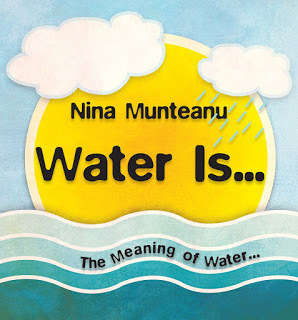
#tardifolk
My Book “Water Is…” by Pixl Press explores this creature and many other interesting things about water. Look for it in Spring 2016 on Amazon, Chapters and in bookstores near you.
www.TheMeaningOfWater.com .
Published on December 16, 2015 19:41
November 30, 2015
An Interview with Lucia Gorea Author of “The Impaler”
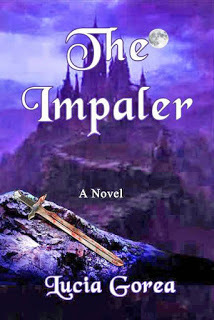 Who was the real Count Dracula? A bloodthirsty vampire? A medieval prince? A ruthless tyrant? Or a famous voivode who skillfully defended his land?
Who was the real Count Dracula? A bloodthirsty vampire? A medieval prince? A ruthless tyrant? Or a famous voivode who skillfully defended his land?In 1442, on a somber morning in Wallachia, Vlad and his younger brother, Radu, bid farewell to their weeping, heartbroken mother. Their father has given them to Sultan Murad II, ruler of the Ottoman Empire, to prove his loyalty to the Turks.
One of the boys will adapt well to captivity. The other won’t…
The Impaler tells a gripping true story of passion, betrayal, resentment, and revenge—and an obsession to conquer and rule.
****Excerpt:
The prince invited them all to an extravagant feast, but they could have never guessed the cost...Vlad orders his servants and soldiers to board up the hall immediately. The beggars look at the vagrants, the sick ones look at the food, while the mothers look at their children, holding and squeezing their tiny hands. Then everyone turns their heads to their right to see many serv- ants bringing in large planks of wood and metal. They start boarding up the room under the terrified looks of the poor and sick. Ready to leave the great hall, some head toward the exit, but Vlad’s soldiers block their way.
Others, the more pious ones, give thanks to the Lord for such a copious feast. They knock themselves over, trying to escape. They push each other and drop the food they hid in their sleeves or underneath their caftans. It falls to the floor. Now they know they are cornered. Wherever they look, they see soldiers and servants. They are nothing but a herd of cattle trapped within the gates of a stable when the storms and thunders hit the plains. Torches are brought in. Burning torches.
Vlad still stands, unflinching. “You will never go hungry from now on. You will never suffer from hunger or thirst, from pain or aches. Your burdens will be lifted.”Startled beggars and horrified vagrants throw themselves on the floor and cover their heads.When Vlad nods, servants and soldiers set the hall on fire.
****
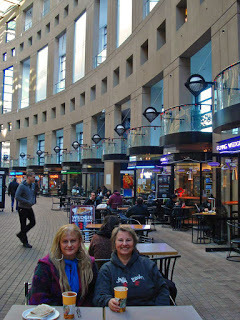 Lucia and Nina at the Vancouver LibraryI recently caught up with Lucia in Vancouver, BC, at UBC after her class and took her to the Flying Pig for drinks. We ordered maple-bourbon smashes and I asked her about the resent release of her debut novel,
The Impaler
:
Lucia and Nina at the Vancouver LibraryI recently caught up with Lucia in Vancouver, BC, at UBC after her class and took her to the Flying Pig for drinks. We ordered maple-bourbon smashes and I asked her about the resent release of her debut novel,
The Impaler
: 1. Your novel “The Impaler” was released by Black Opal Books this past October and tells the tale of Vlad, Prince of Wallachia—otherwise known as Count Dracula. Some will see this as another version of Bram Stoker’s Count Dracula legend. Is there any similarity? What is the main difference in your story from the Dracula legend and how would you describe “The Impaler”? I believe the only similarity between the two versions is that both Bram Stoker and I based our novels on the same character, Count Dracula. We both placed our stories in medieval Transylvania and described the bloodthirsty prince through our own perception. The main difference between our novels is that Stoker associated Dracula with vampirism. He portrayed Vlad as a bloodthirsty vampire. He based his novel solely on his imagination, creating an imaginary character. He has never set foot in Transylvania. My novel is based on facts. The events, names, places and characters in “The Impaler” accurately portray Transylvania and Wallachia of the Middle Ages during Vlad’s reign. I was born in Transylvania, visited Vlad’s castles, and studied this historical figure in school.
2. What inspired you to write “The Impaler”?The idea of writing a novel on the real prince Dracula, also known as “The Impaler,” came to me a long time ago, when I realized that he was wrongly perceived as a vampire and that very few people knew that a real historical figure existed behind the fantasy character. I do remember vividly the moment I decided to tackle this subject. A few years ago, I was waiting in line at a grocery store in Portland, Oregon where I used to live. The clerk asked me where I was originally from, and when he learned that I was born in Transylvania, he asked me if that place really existed and if vampires lived there. I joked and told him that there were vampires in Transylvania and that I was one of them, to the bemusement of the other shoppers. He really believed me and said that he had never seen a vampire before. That was the moment I knew my mission was to inform people like him that Count Dracula really existed, that he was a real prince, and to inform readers about the significant role he had in the medieval history.
3. I know you did a lot of research to assure historical accuracy. Can you tell us a little about that process? You are right, Nina. This historical thriller is based on extensive research that I conducted using chronicles, biographies, pamphlets and historical materials in both online and paper format. It was very important to me to convey the real story of Vlad Dracula, the prince of many faces, and to accurately portray this controversial historical figure during his reign in the Middle Ages.
4. Vlad is painted with vivid detail—the nuances of his complex and paradoxical character flow with a chilling reality. What process did you use to achieve that?I have always been fascinated by Vlad’s persona. I remember studying Vlad Dracula in my history class in high school. His powerful image haunted me through the years. I admired his strength and skills, and his ability to rule in a lawless country. I was appalled by the gruesome atrocities he committed. But were there any other ways to defend your land, your country and religion in the Middle Ages? I used the present tense to depict Wallachia and Transylvania of the 15thcentury. This is because the scenes unfolded in front of my eyes, like a vivid movie with clear images, distinct voices, sounds and colors. I could hear the protagonists’ dialogues, I could feel their emotions, I could see their facial expressions, the clothes they were wearing, and the interiors of the medieval castles. I could sense their anger, or resentment, their love or hatred. In fact, I visualized everything. I felt I literally lived in the Middle Ages, and that I was part of the story. It seemed that I was either the spectator at times, one of the protagonists, or the narrator. There were times when I could hardly remove myself from the scenes I depicted so passionately and get back to reality.It has been by far the most thrilling and fascinating literary adventure I have ever experienced.
5. You are an acclaimed poet and teach writing at UBC in Vancouver. Do you think that your poetry background had any affect on your prose writing for “The Impaler”? It surely did. My poetry background allowed me to get in touch with my inner feelings and perceive the protagonists’ emotions in depth. The use of metaphors, epithets, comparisons, and analogies in the novel give the story a more realistic and humane aspect that the readers can easily identify with. 6. Can you describe your writing process for completing this book? How long did it take to finish?Writing this novel was an assiduous project and required extensive research. I first started by brainstorming ideas and gathering the information I needed about the places, characters, historical facts and events I was going to depict in the novel. I consulted many online and paperback chronicles and articles for accuracy and relevance to my story. I researched several books and catalogues at local libraries and learned about medieval life, food, clothing, literature, arts and culture, as well as social diversity. I also read about the Ottoman Empire and the role it had in medieval history. The next step was to create the outline—the skeleton of the story. Then I started building on what I had and developed, as accurately as I could, the life of the real Prince Dracula. It took me a little over two years to complete the book.
7. Tell us a little bit about your current writing project.I am currently working on a couple of projects. One is a fictional novel on dating and relationships, yes, that’s right, the new trend that millions of people around the world experience nowadays. It is entitled, “How I Met You Online.” The other project I am working on is a book for non-native college students, “100 ESL Board Games.” I’m also translating fairy tales and legends, as well as poetry from Romanian into English.
8. Where can we find your other books?My books can be found on Amazon, BarnesandNoble.com, Kobo, Kindle, BlackOpalBooks.com, All Romance, Alibris.com, and other fine retailers where books are sold.
Thank you, Lucia!
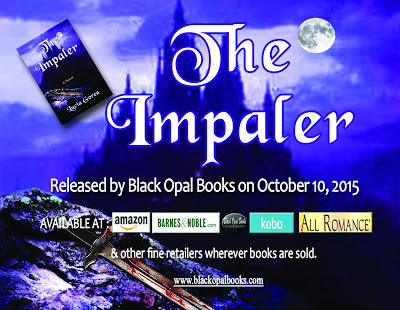
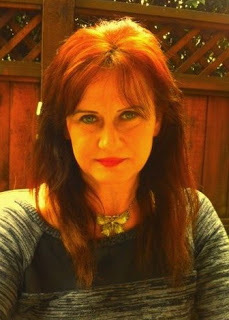 Lucia Gorea
is a Canadian poet and writer who has authored fourteen books, award-winning poems and articles. Some of her books include Welcome to America!, Journey Through My Soul, ESL Games and Classroom Activities, Yukon the Polar Bear, and Speak English for Success.Originally from Transylvania, Romania, Gorea graduated from the University of Bucharest with degrees in English, French and Linguistics then earned her PhD in English and Education from Atlantic International University. She taught various post-secondary English and writing courses in the USA before settling in Vancouver, Canada, in 2005 to teach and write. Gorea founded Poetry Around the World, a multicultural reading series in Vancouver to help promote non-native poets and writers, and hosted radio and television poetry shows. Lucia Gorea is also a professional translator and was selected as keynote speaker at The 8th International Symposium on Translation, Interpretation, and Terminology in Havana, 2013. Gorea’s interest in history inspired The Impaler —her debut novel.
Lucia Gorea
is a Canadian poet and writer who has authored fourteen books, award-winning poems and articles. Some of her books include Welcome to America!, Journey Through My Soul, ESL Games and Classroom Activities, Yukon the Polar Bear, and Speak English for Success.Originally from Transylvania, Romania, Gorea graduated from the University of Bucharest with degrees in English, French and Linguistics then earned her PhD in English and Education from Atlantic International University. She taught various post-secondary English and writing courses in the USA before settling in Vancouver, Canada, in 2005 to teach and write. Gorea founded Poetry Around the World, a multicultural reading series in Vancouver to help promote non-native poets and writers, and hosted radio and television poetry shows. Lucia Gorea is also a professional translator and was selected as keynote speaker at The 8th International Symposium on Translation, Interpretation, and Terminology in Havana, 2013. Gorea’s interest in history inspired The Impaler —her debut novel. Lucia Gorea lives in Vancouver, B.C. and teaches English at the University of British Columbia, Mosaic Language Centre, and Atlantic International University. She is currently writing her second novel. Visit www.luciagorea.com to find out more about her writing.
Published on November 30, 2015 09:33
November 10, 2015
Nina Talks Writing and Water on "Liquid Lunch" That Channel TV
I recently appeared on That Channel to discuss the writing process and my upcoming book on water called "Water Is...", due early in 2016.
Here's the interview with Hugh Reilly and Hildegard Gmeiner:
The final cover by Aurora finalist Costi Gurgu is out and here it is! More on the cover and the book later...
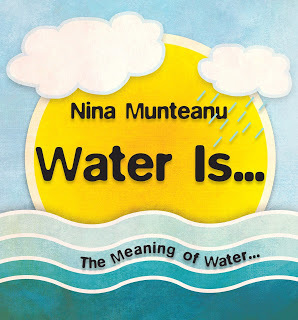
Here's the interview with Hugh Reilly and Hildegard Gmeiner:
The final cover by Aurora finalist Costi Gurgu is out and here it is! More on the cover and the book later...

Published on November 10, 2015 09:27
September 17, 2015
Nina Teaching SF Writing Course at George Brown College FALL 2015
I'm back at George Brown College, teaching my 12-week long writing course on how to write science fiction. "Creating Science Fiction" is now part of George Brown's Creative Writing Certificate.
The 12-week course starts SEPTEMBER 22 (TUESDAY) and runs until DECEMBER 8th.

Called “Creating Science Fiction”, the course runs TUESDAY nights from 6:15 to 9:15 starting September 22nd through to December 8th and costs $285.
Meant for both beginning writers and those already published, the 12-week course is run like a workshop with student input and feedback on student’s WIPs. Munteanu explores with students the essential tools used in the SF genre (including world building, research and plot approaches). “Students will work toward a publishable original piece by learning to generate and follow through with premise, idea and theme,” says Munteanu.
You can register for the course here: http://coned.georgebrown.ca/owa_prod/cewskcrss.P_CrseGet?subj_code=LIBA&crse_numb=9351George Brown College is located on 200 King Street, Toronto, Canada.
The 12-week course starts SEPTEMBER 22 (TUESDAY) and runs until DECEMBER 8th.

Called “Creating Science Fiction”, the course runs TUESDAY nights from 6:15 to 9:15 starting September 22nd through to December 8th and costs $285.
Meant for both beginning writers and those already published, the 12-week course is run like a workshop with student input and feedback on student’s WIPs. Munteanu explores with students the essential tools used in the SF genre (including world building, research and plot approaches). “Students will work toward a publishable original piece by learning to generate and follow through with premise, idea and theme,” says Munteanu.
You can register for the course here: http://coned.georgebrown.ca/owa_prod/cewskcrss.P_CrseGet?subj_code=LIBA&crse_numb=9351George Brown College is located on 200 King Street, Toronto, Canada.
Published on September 17, 2015 14:52



